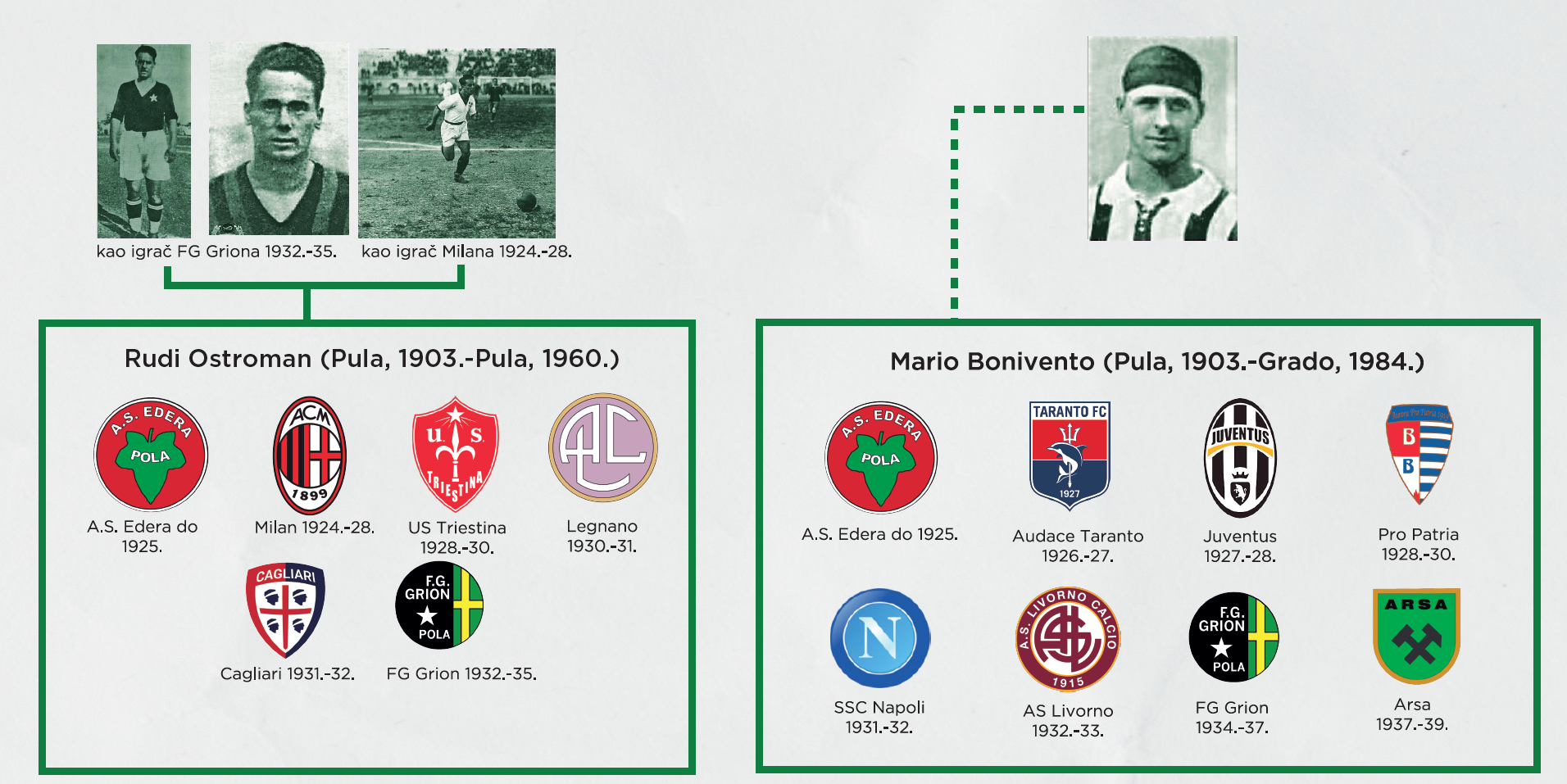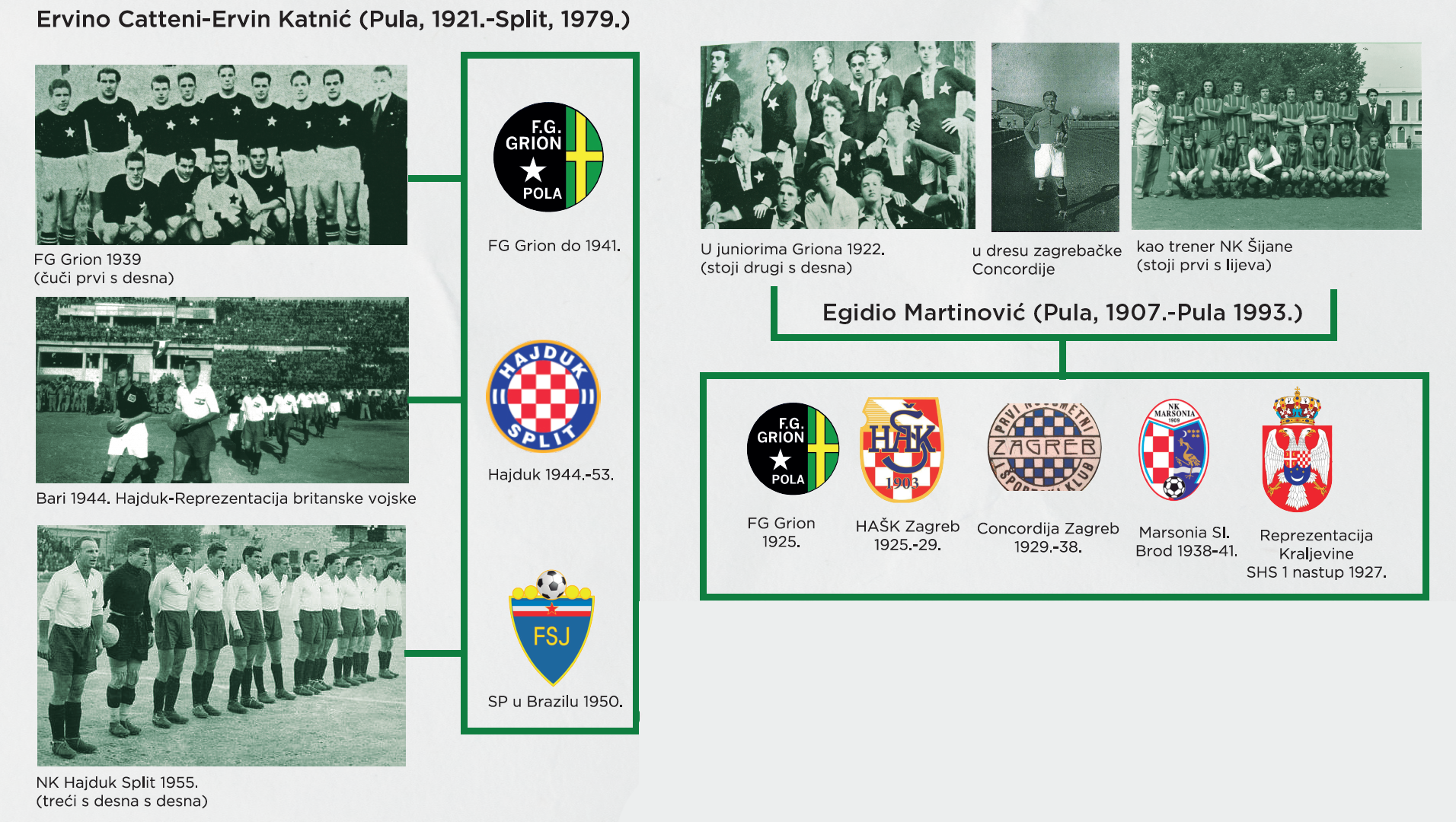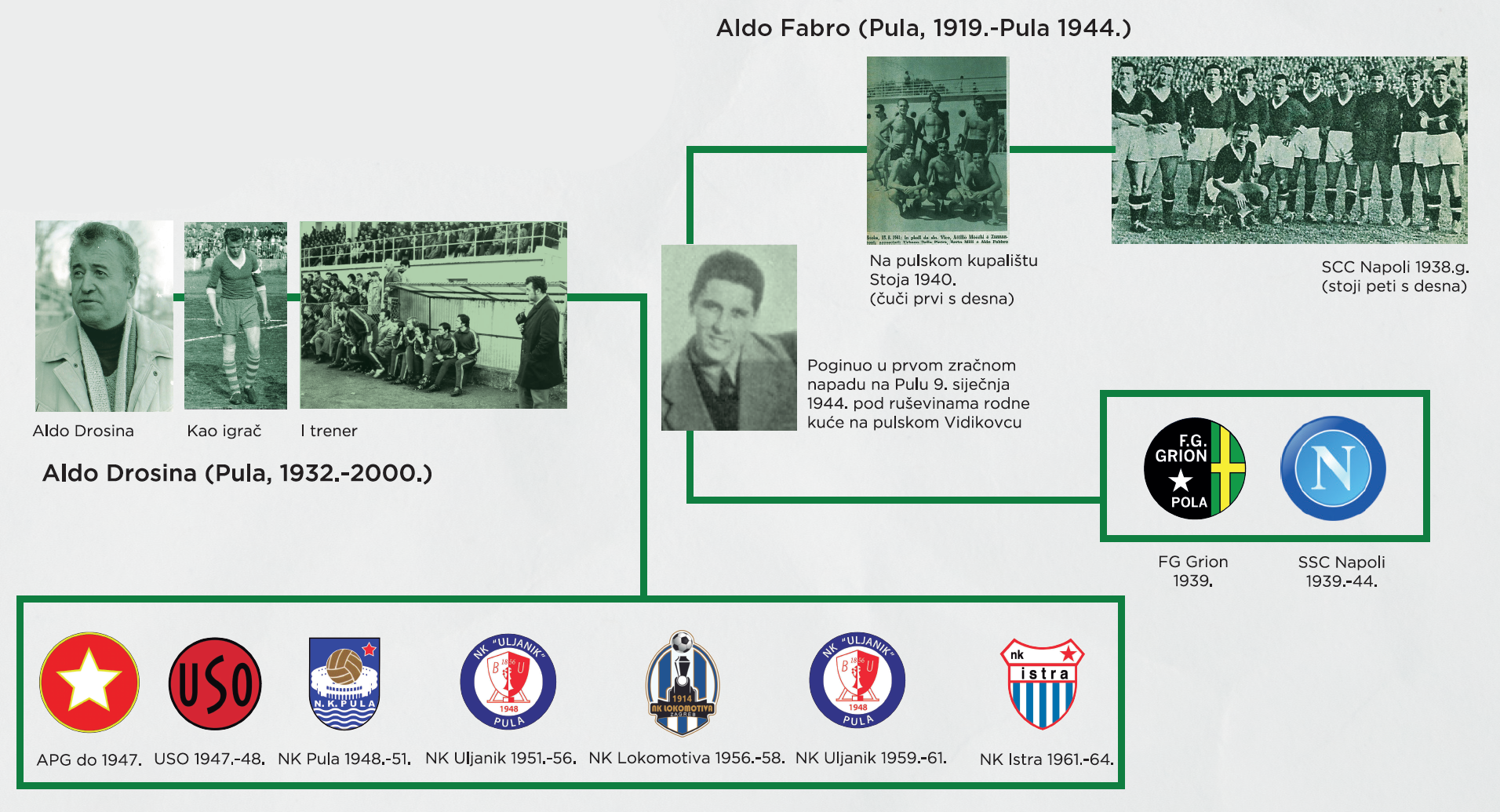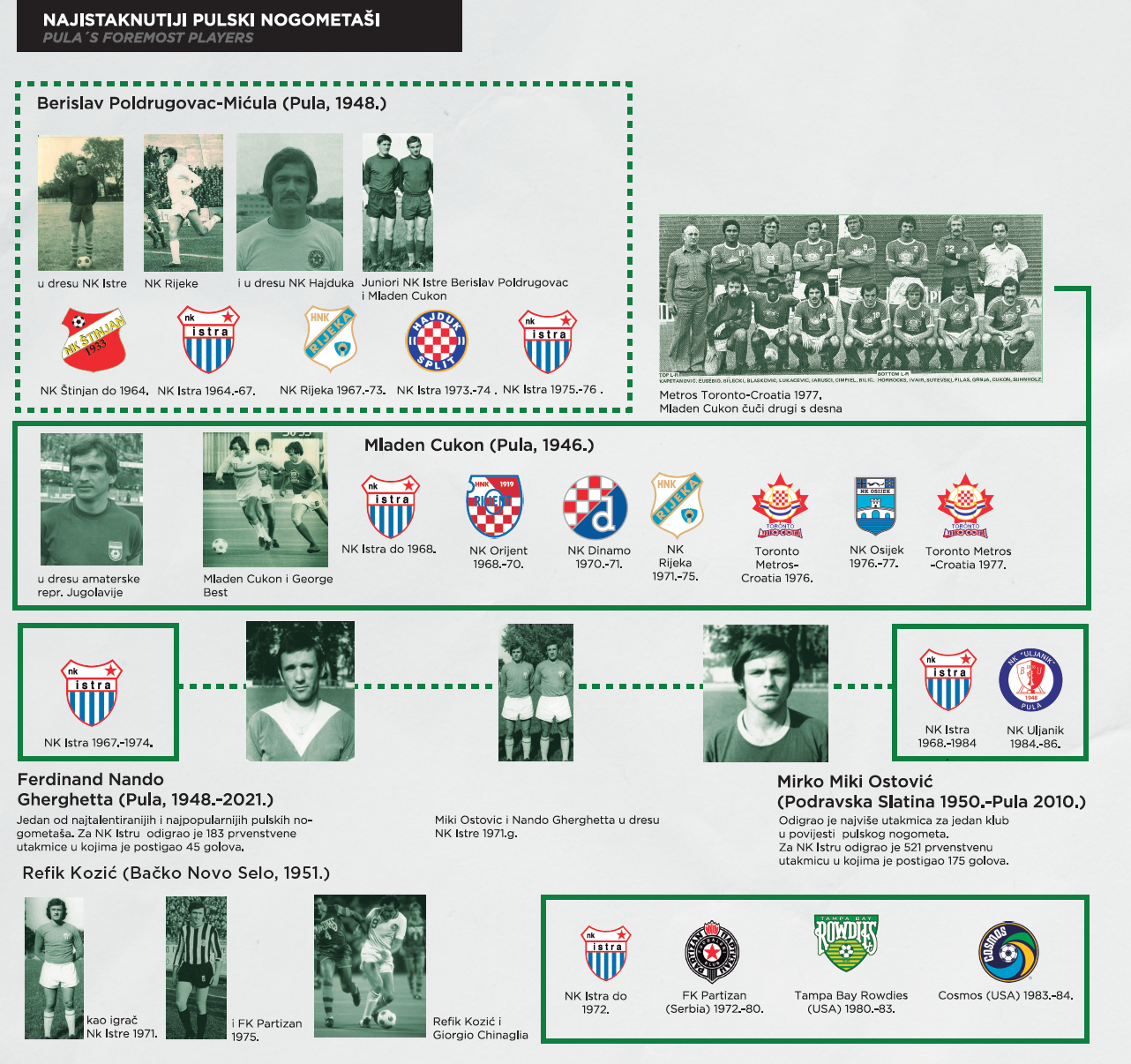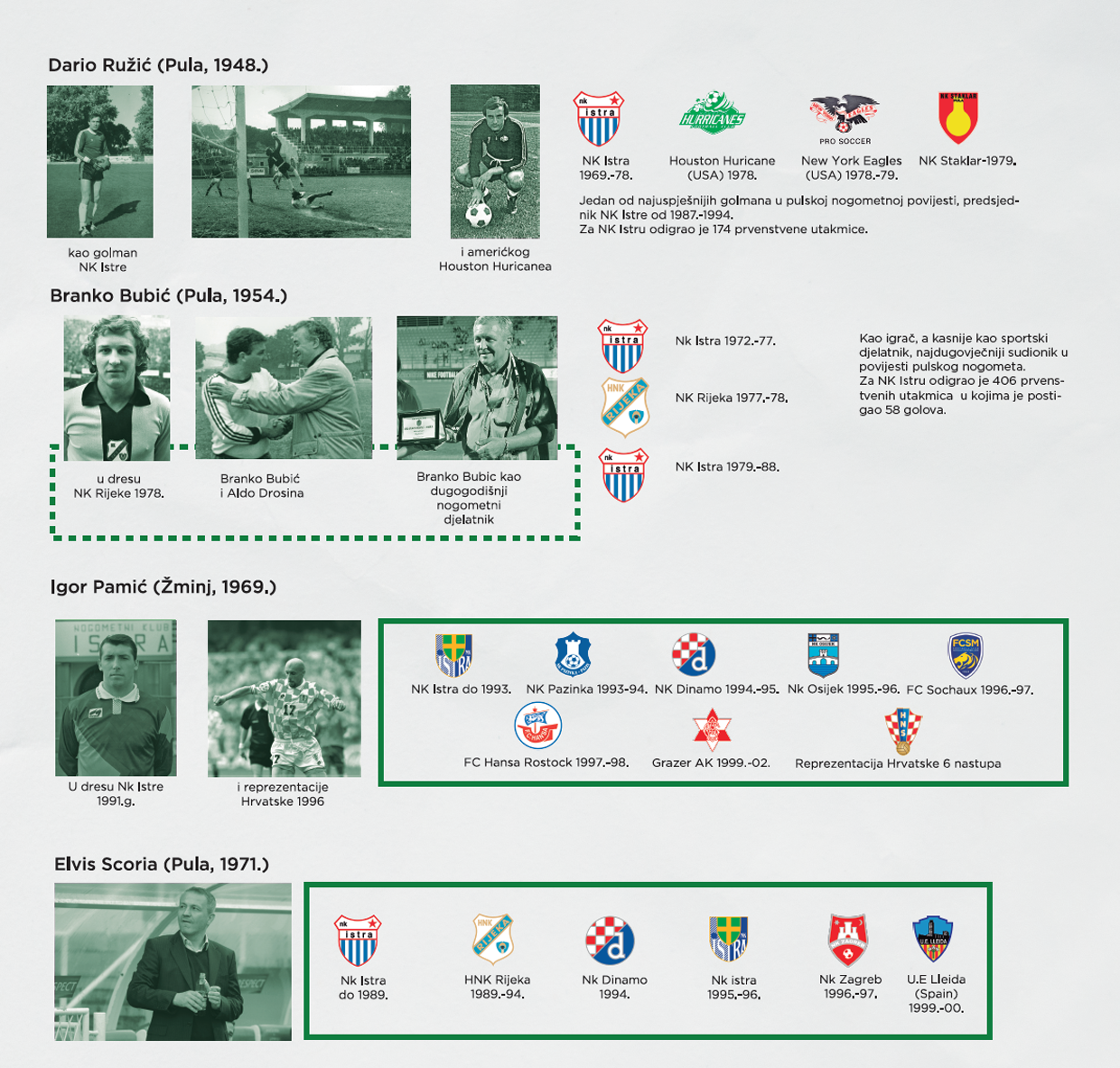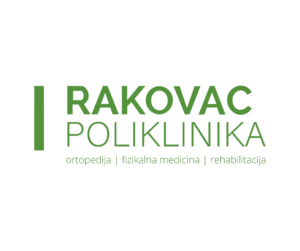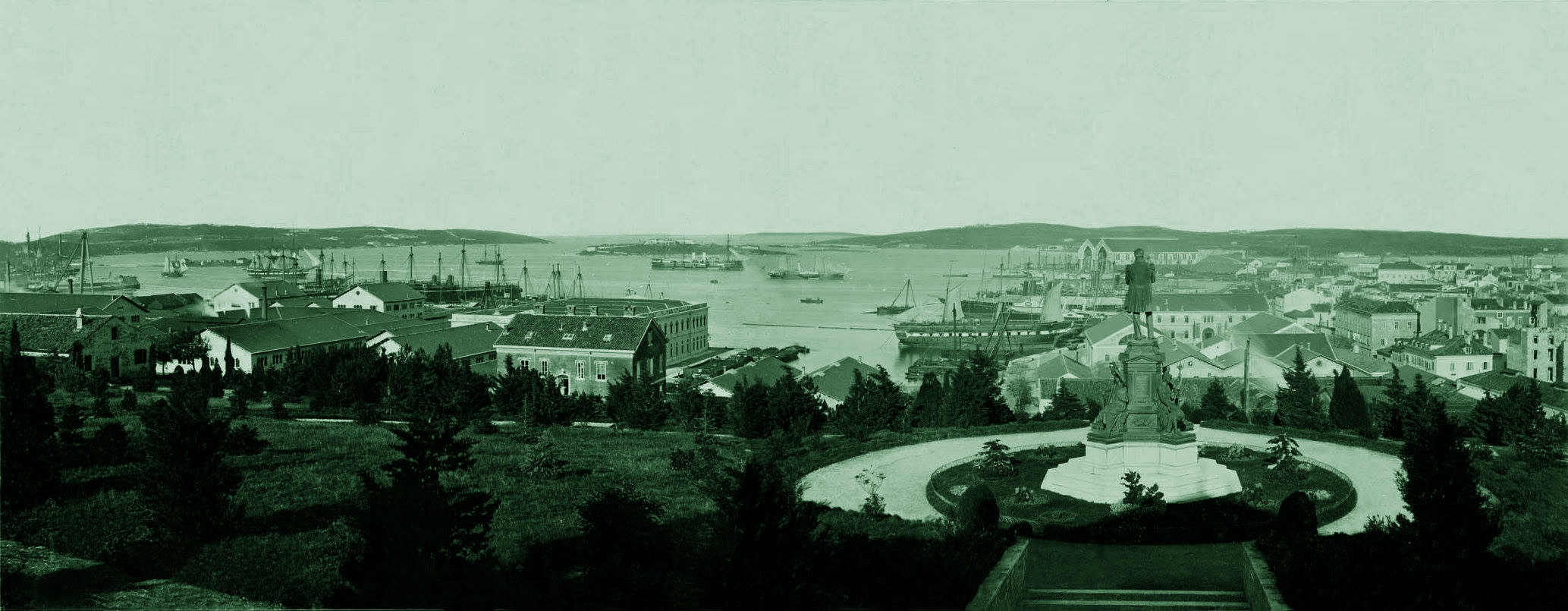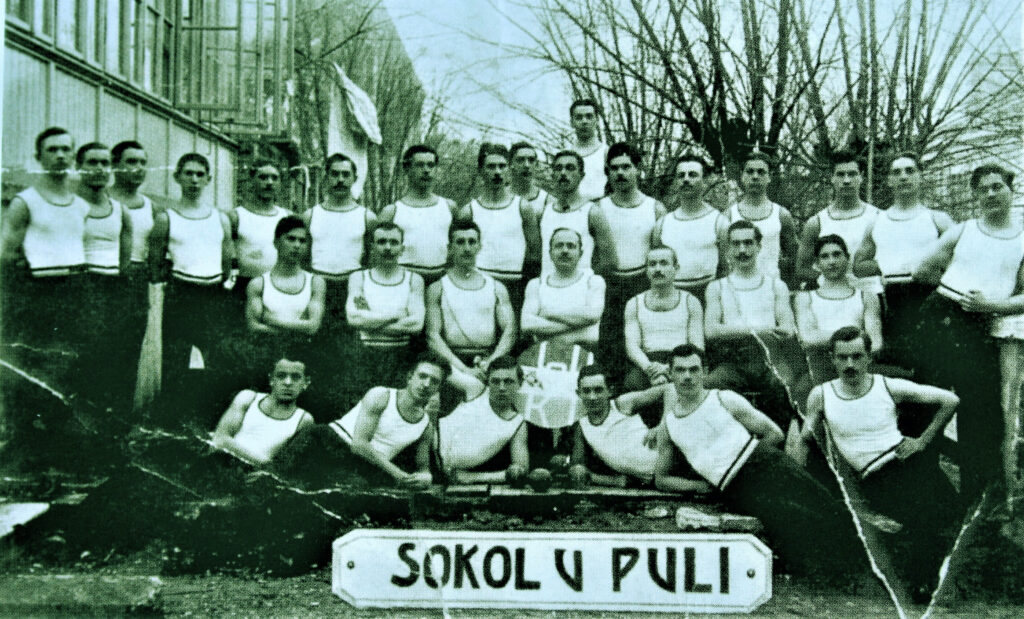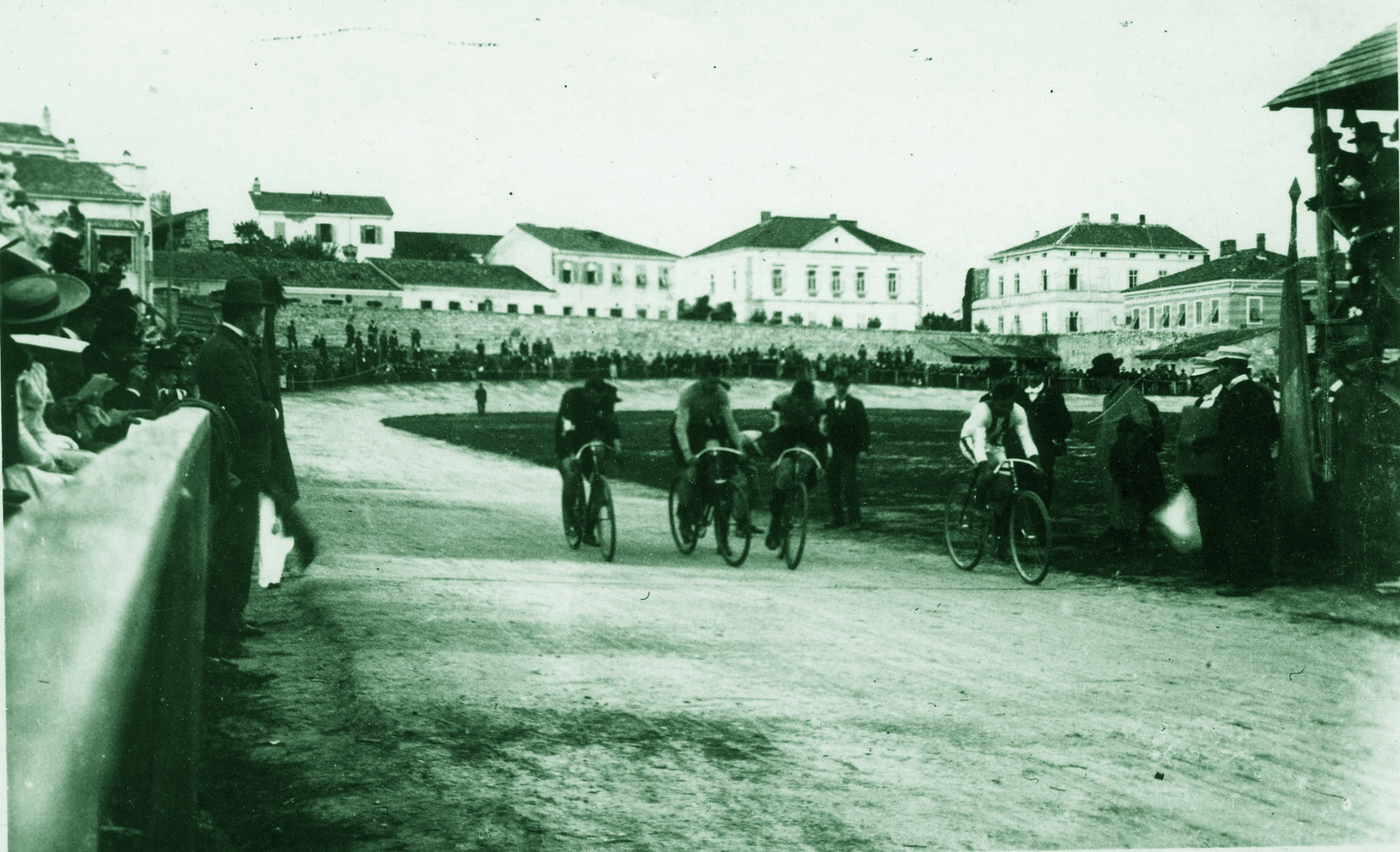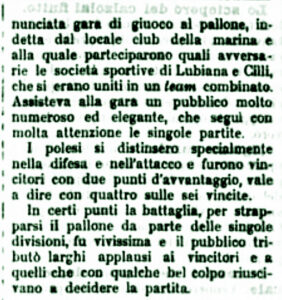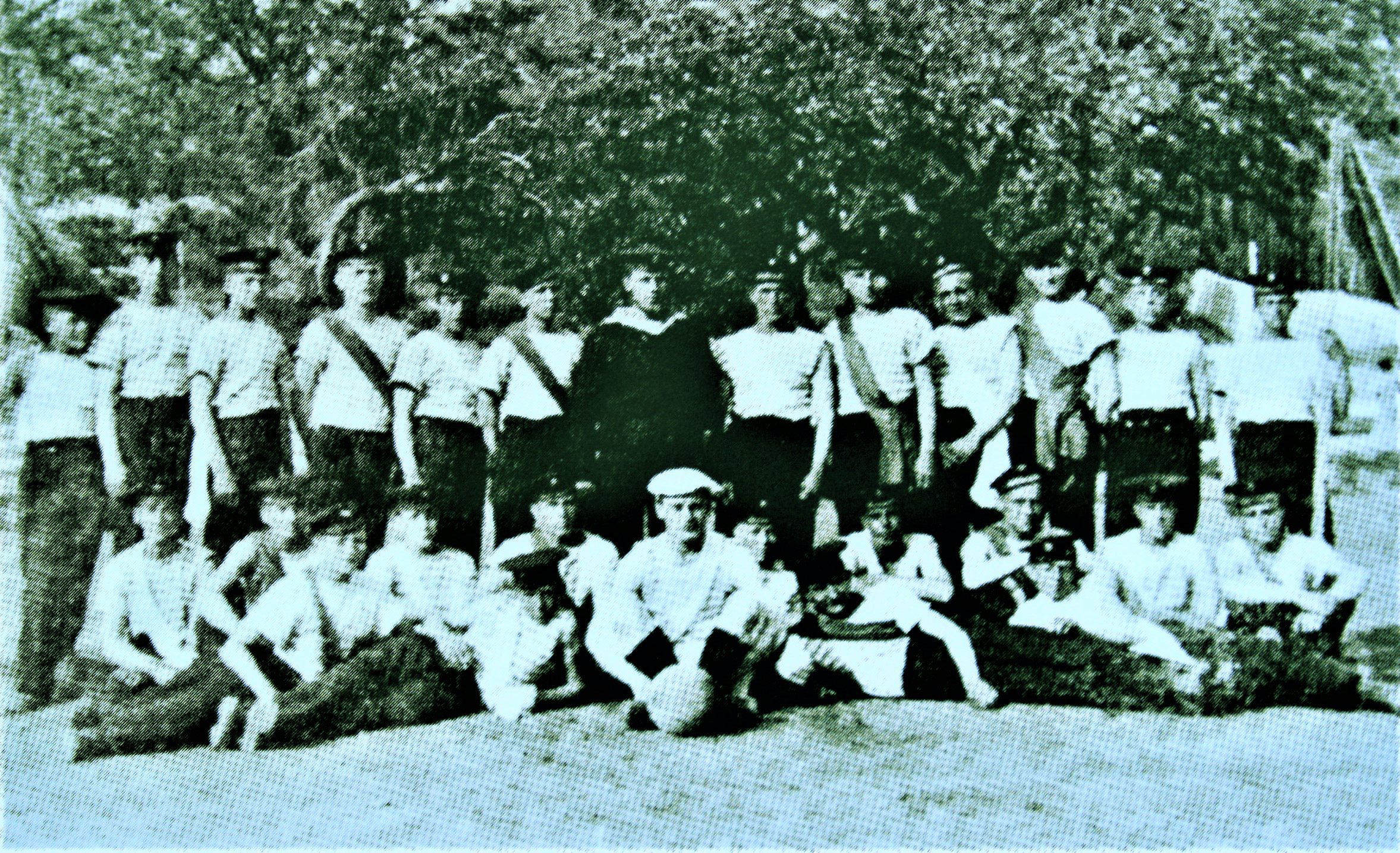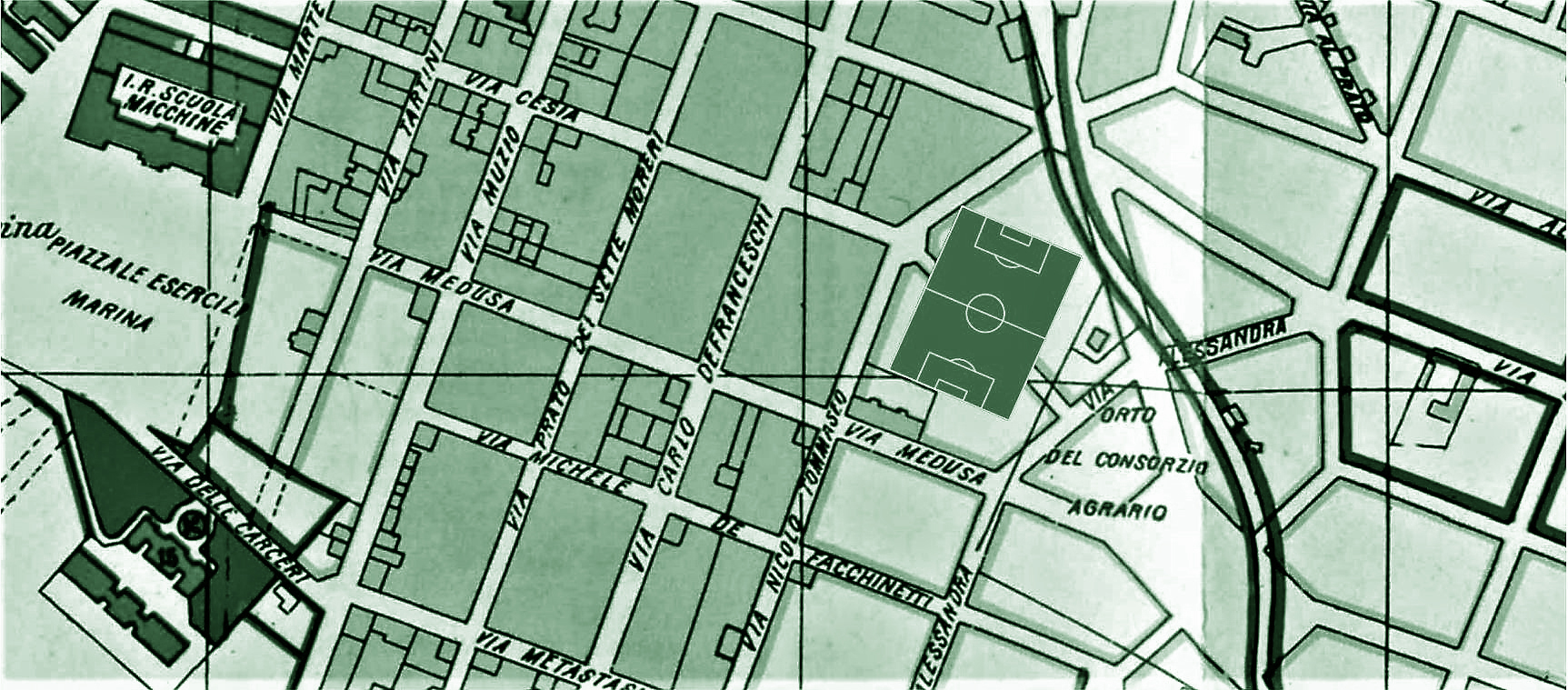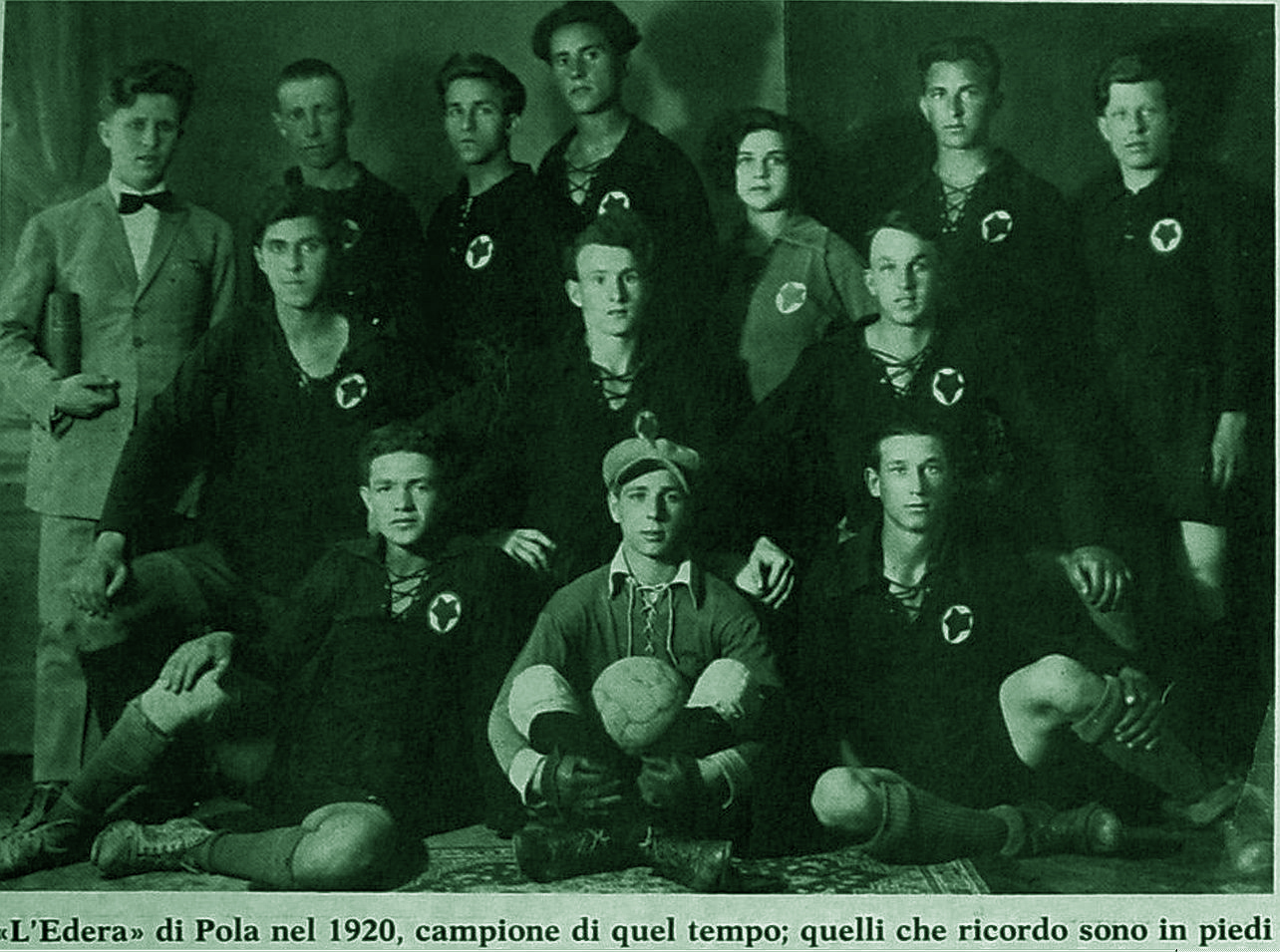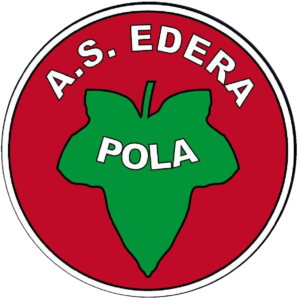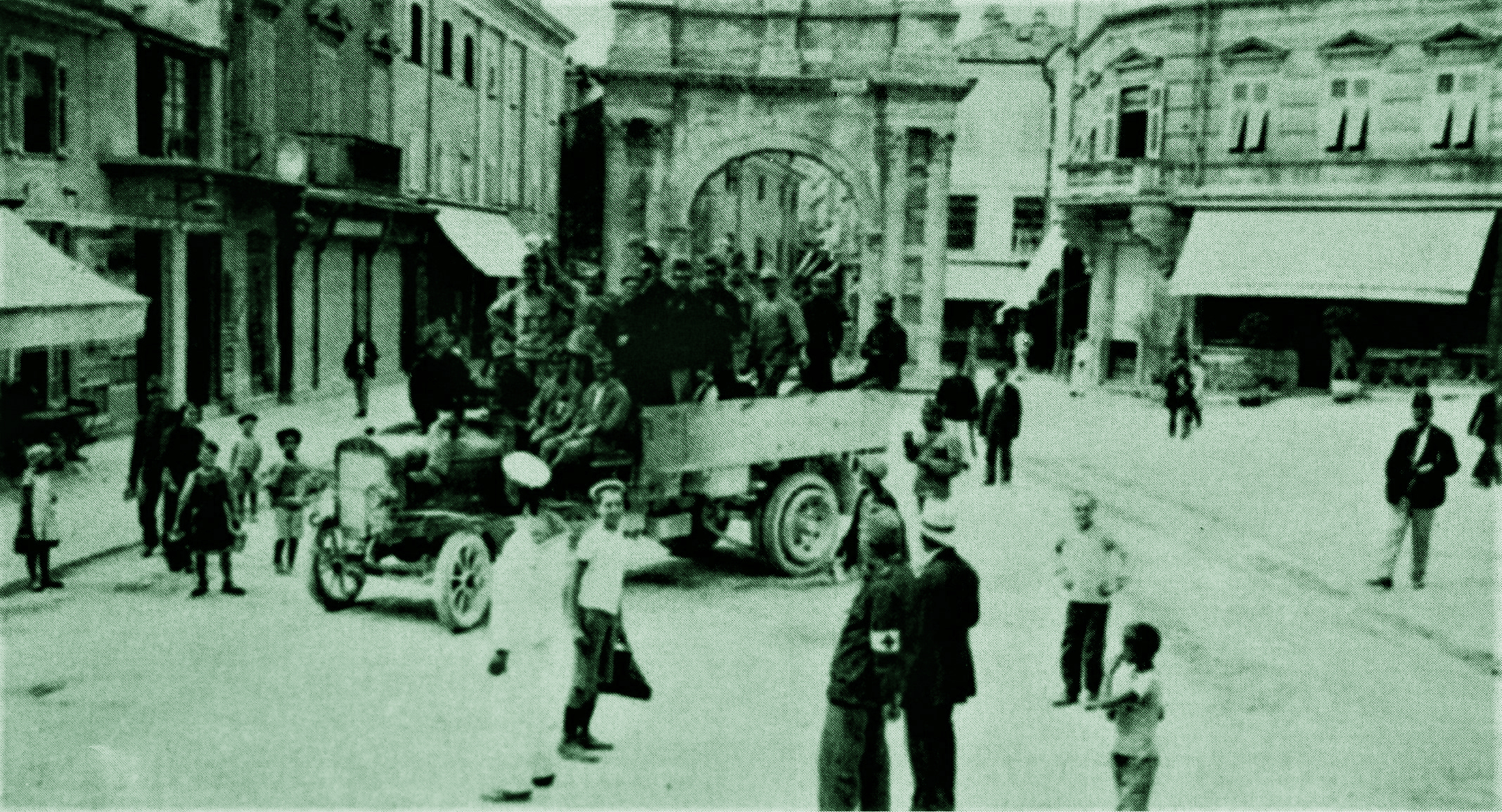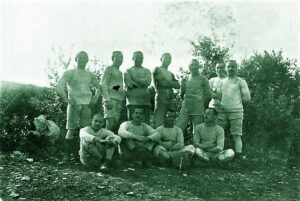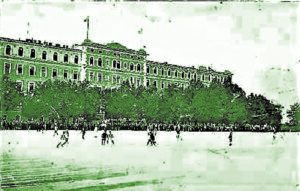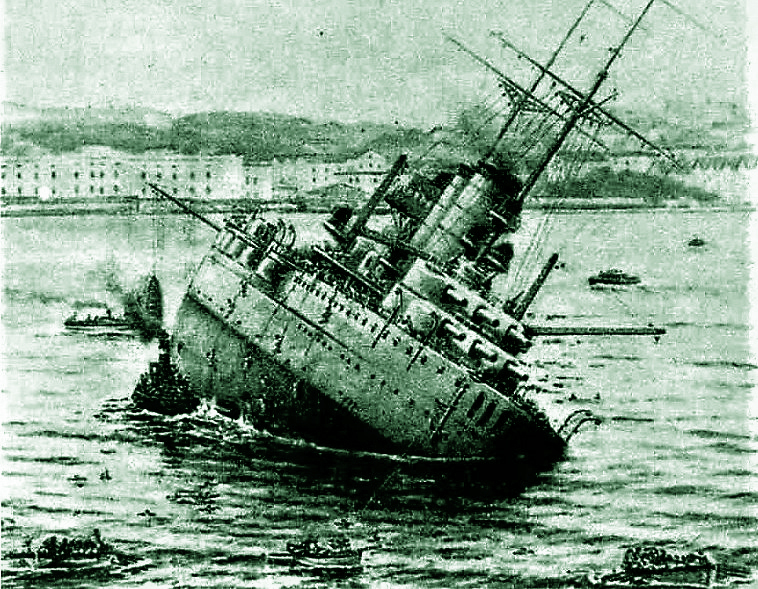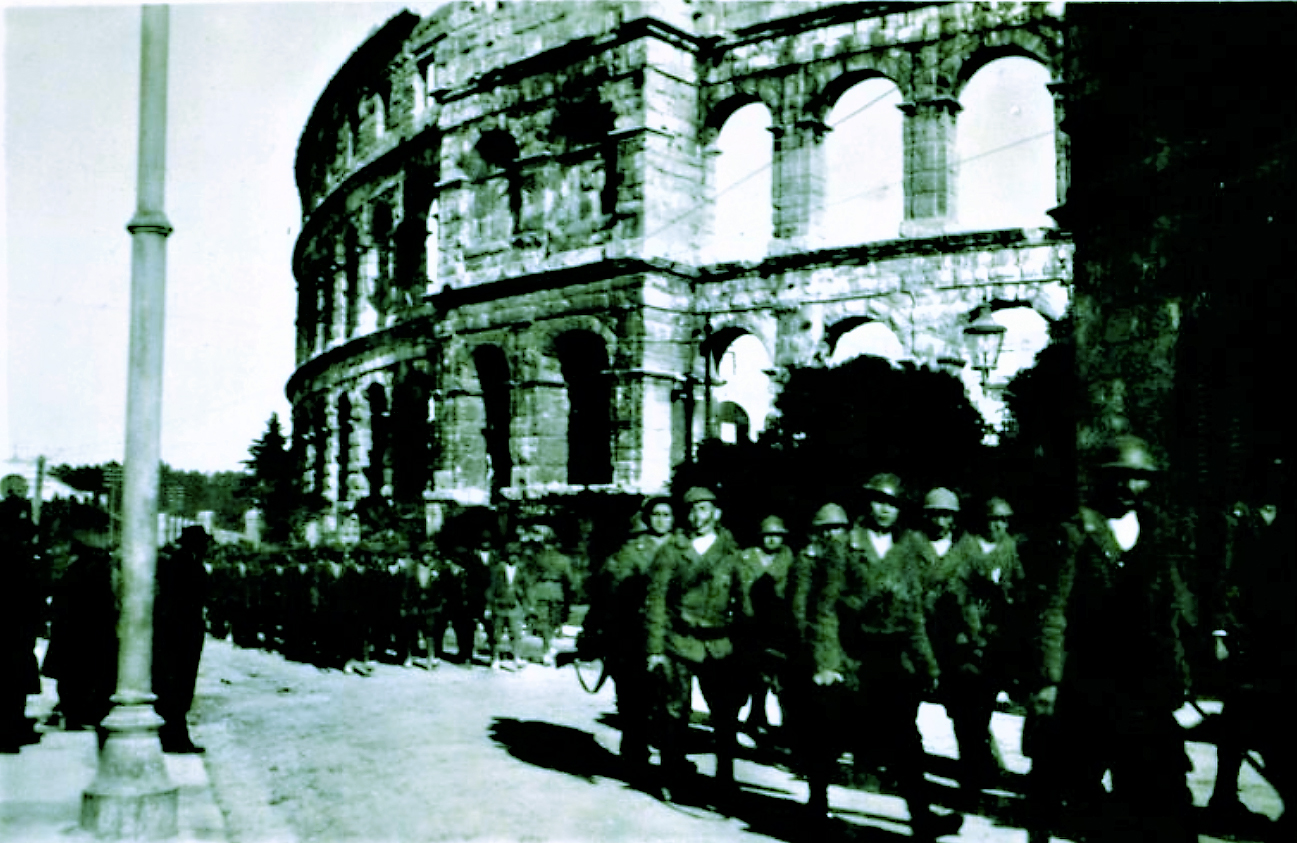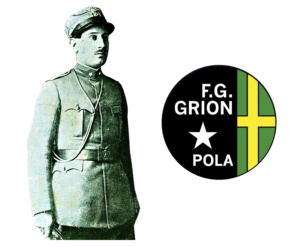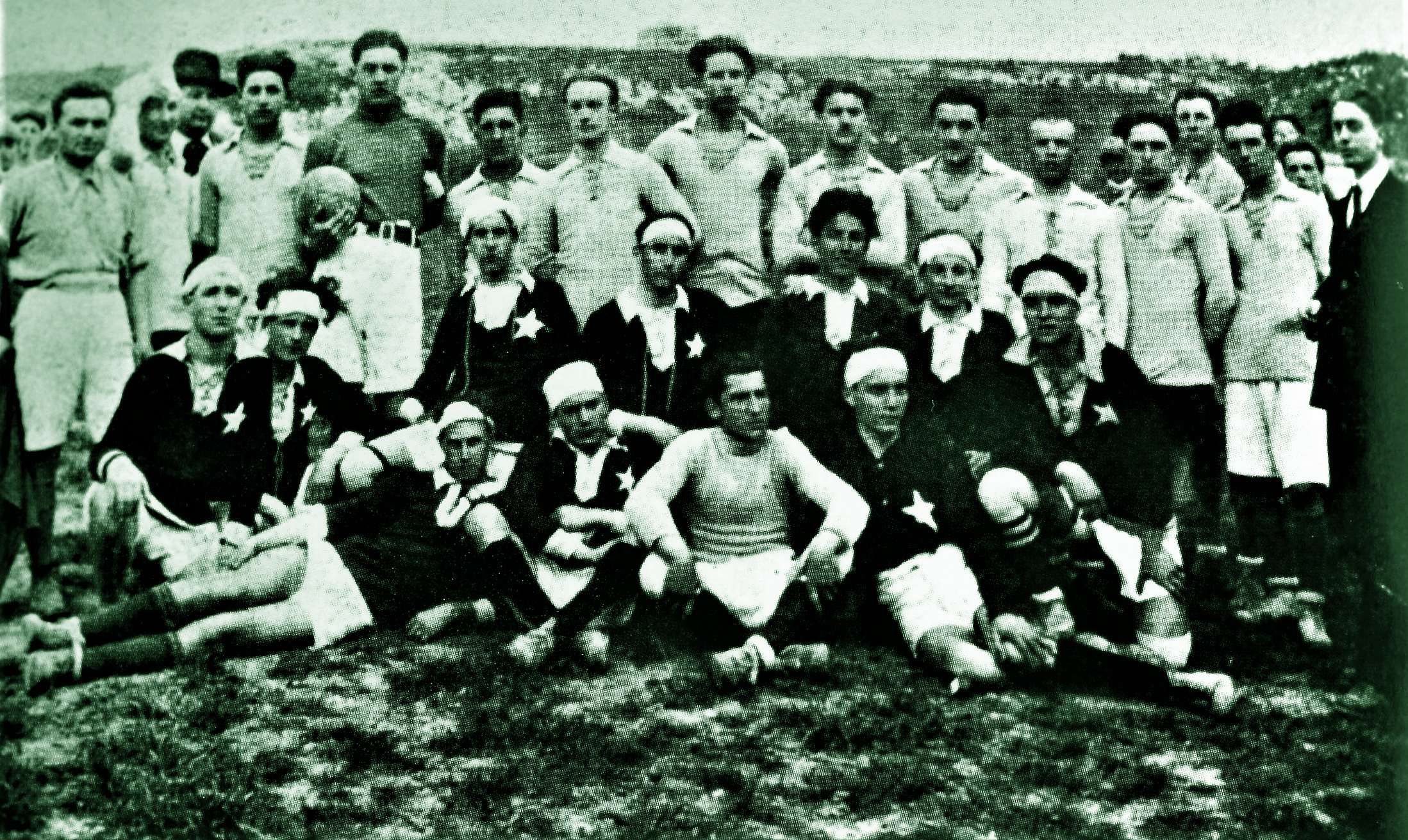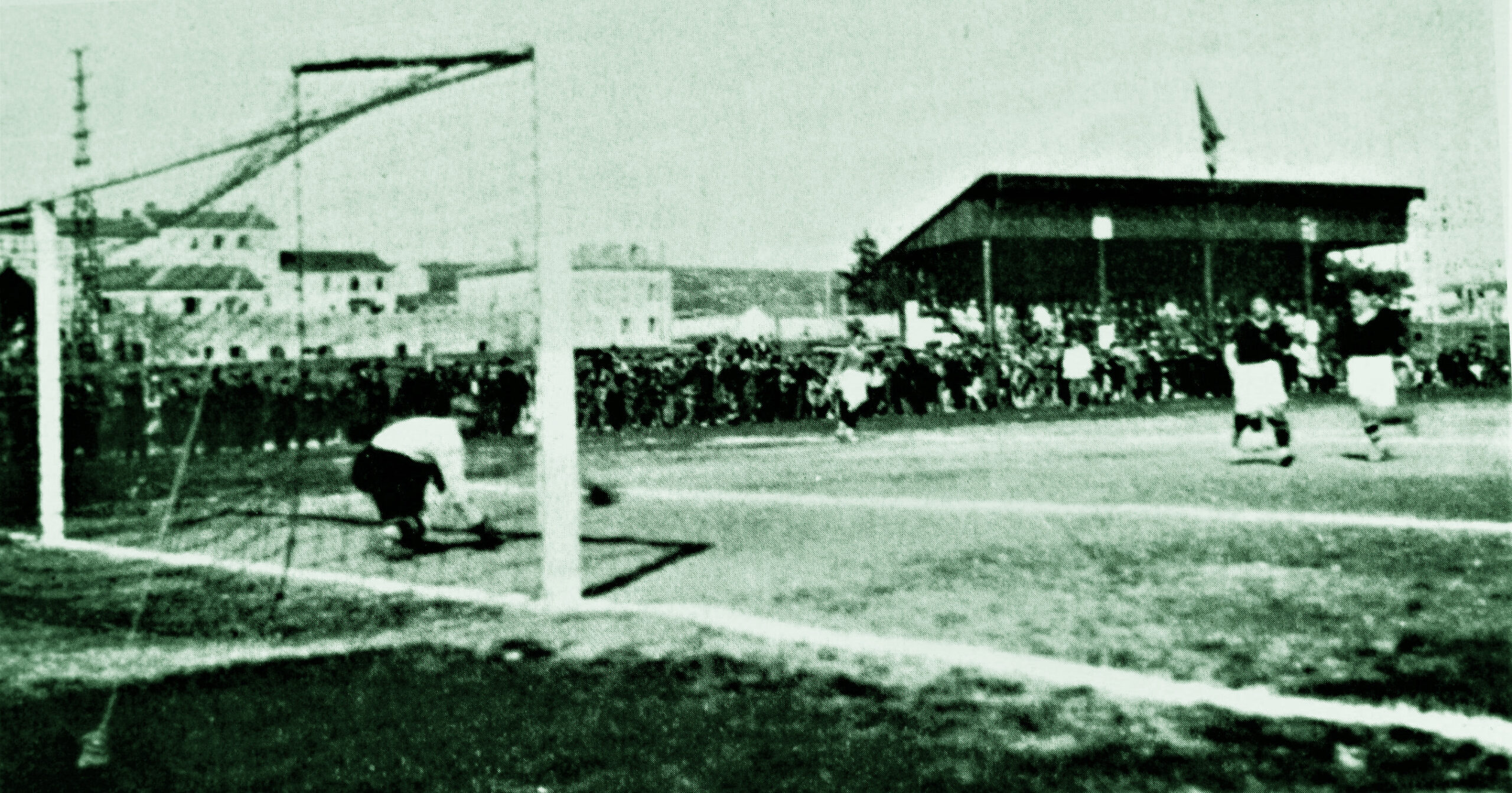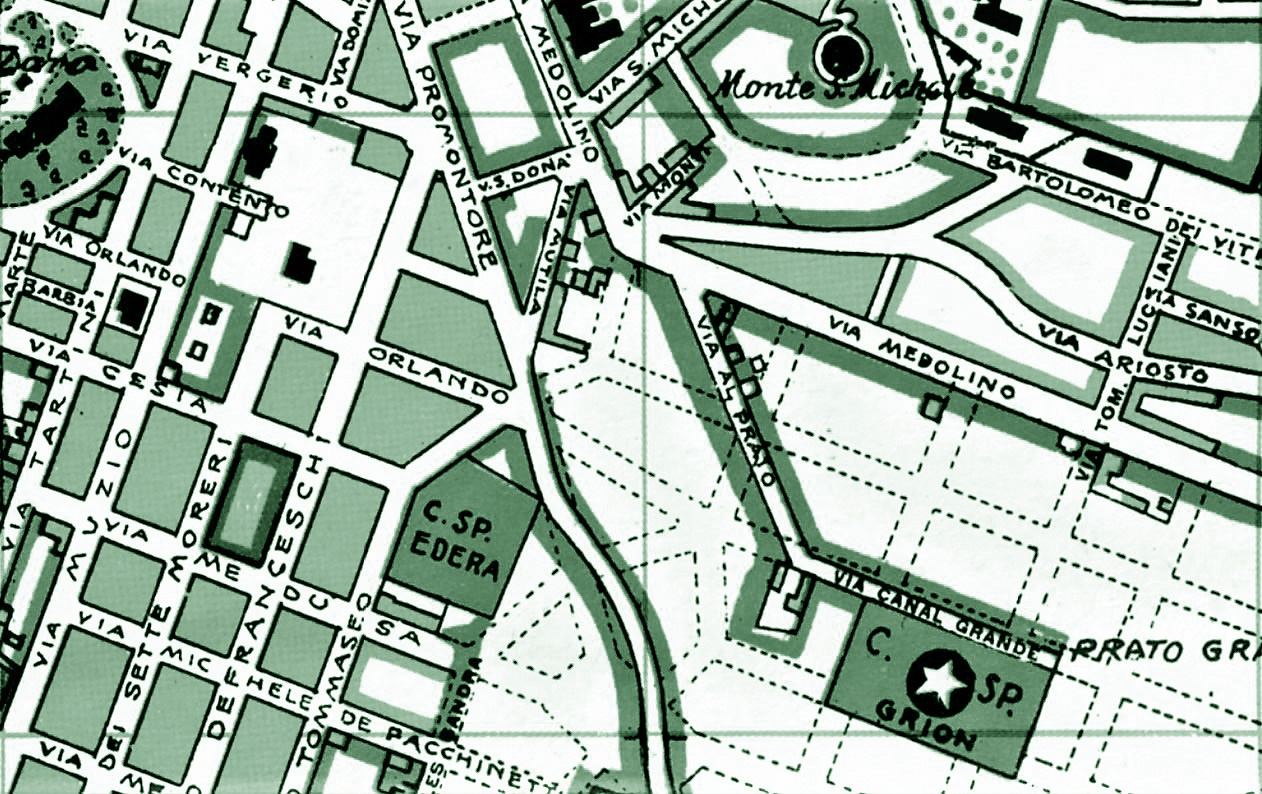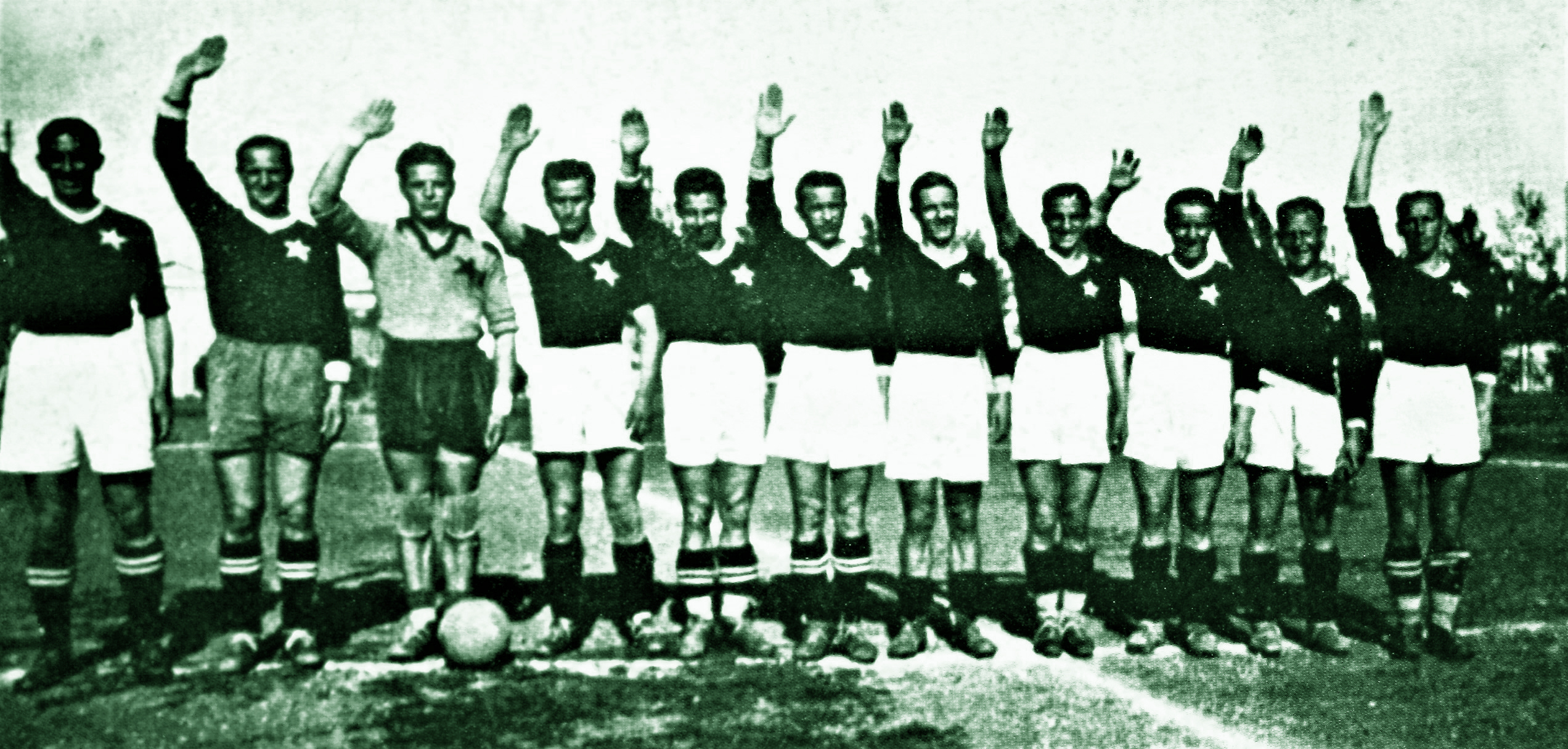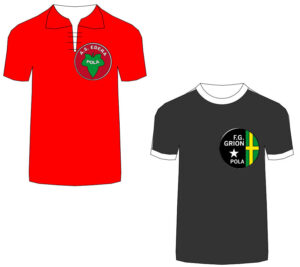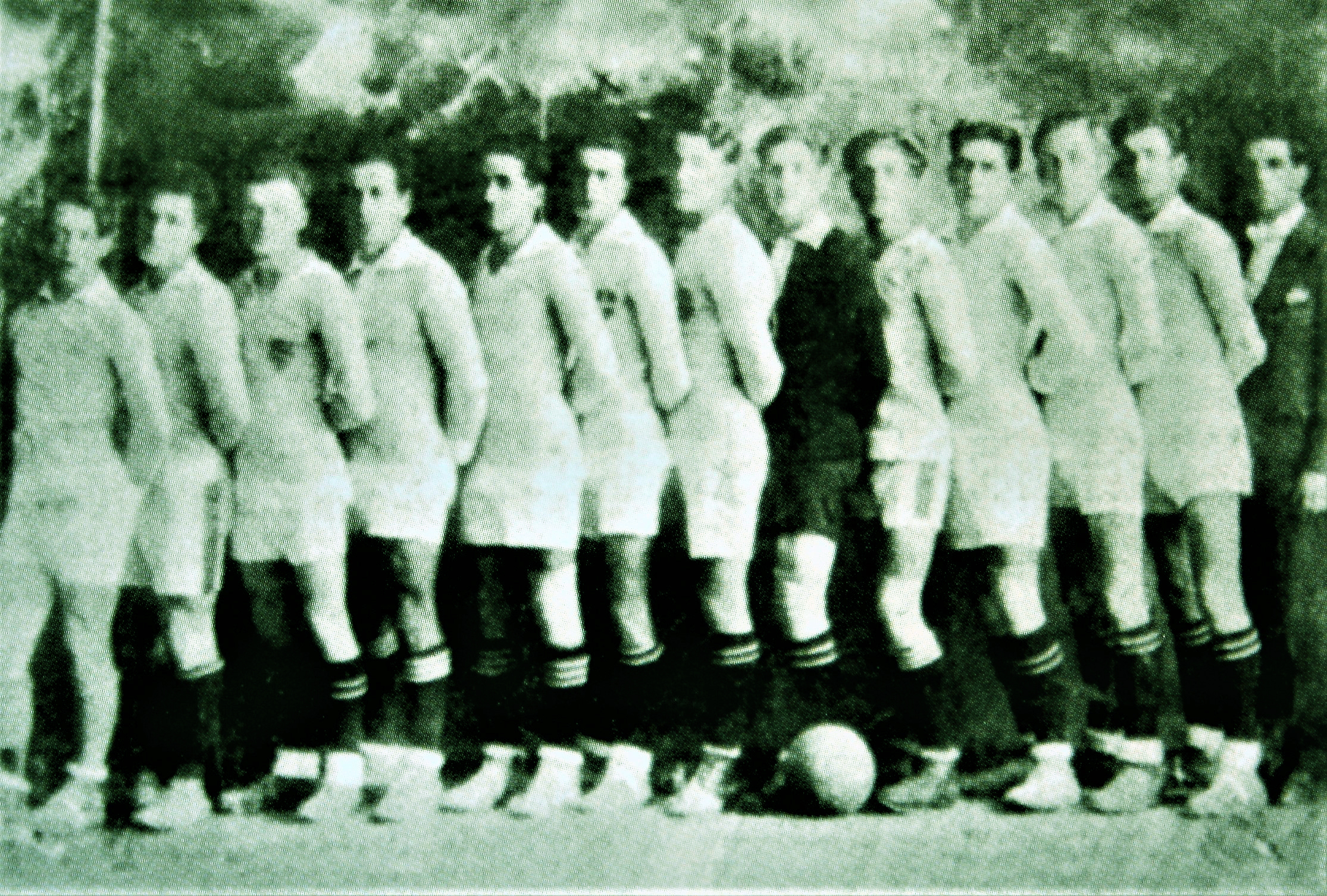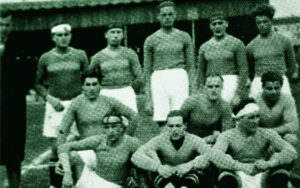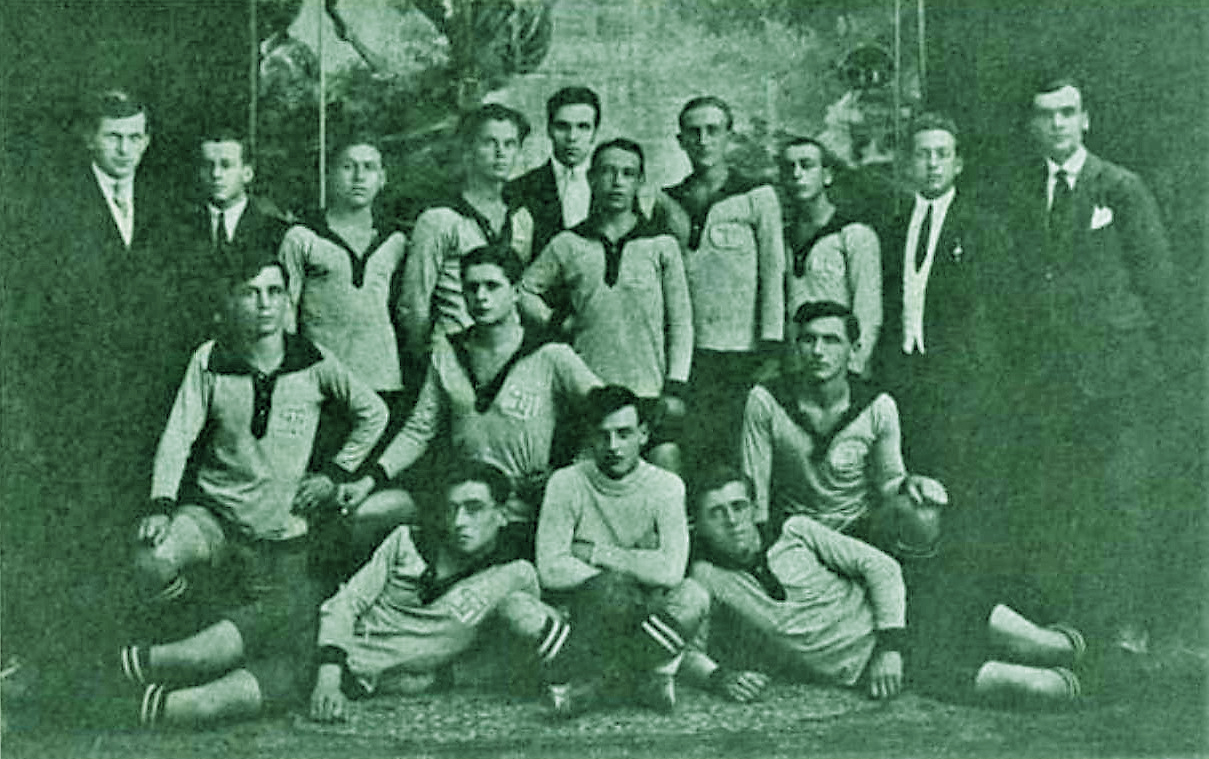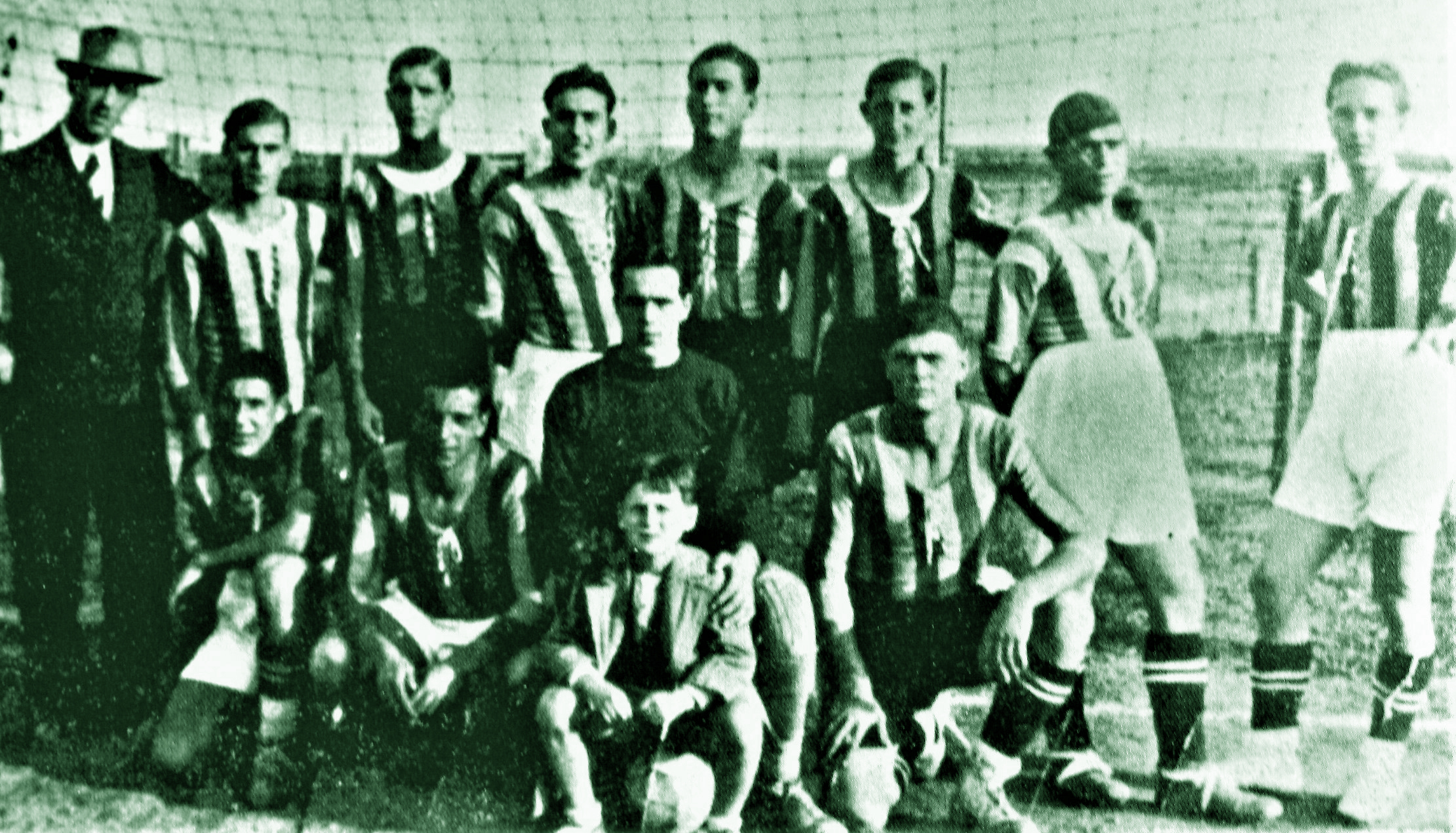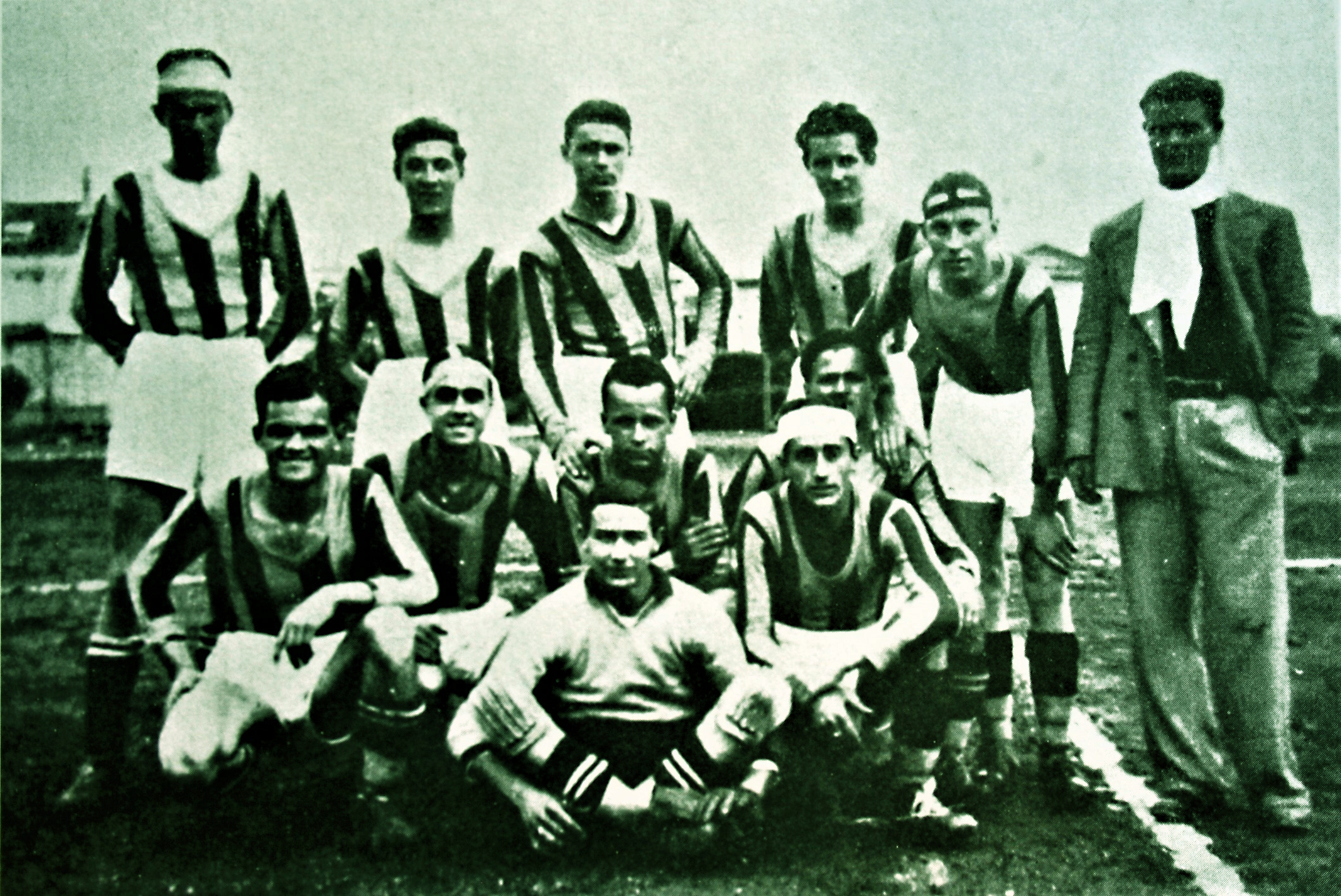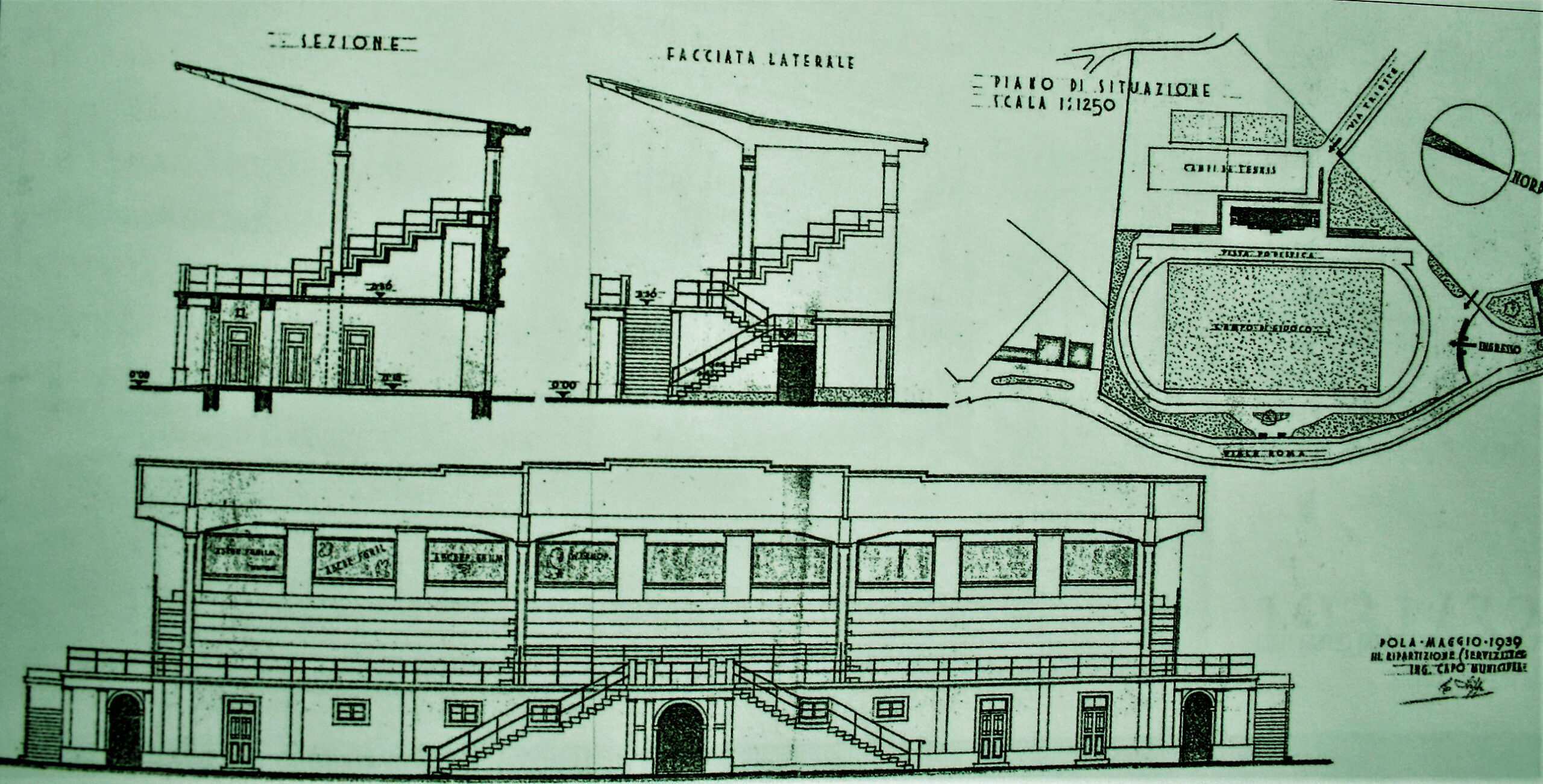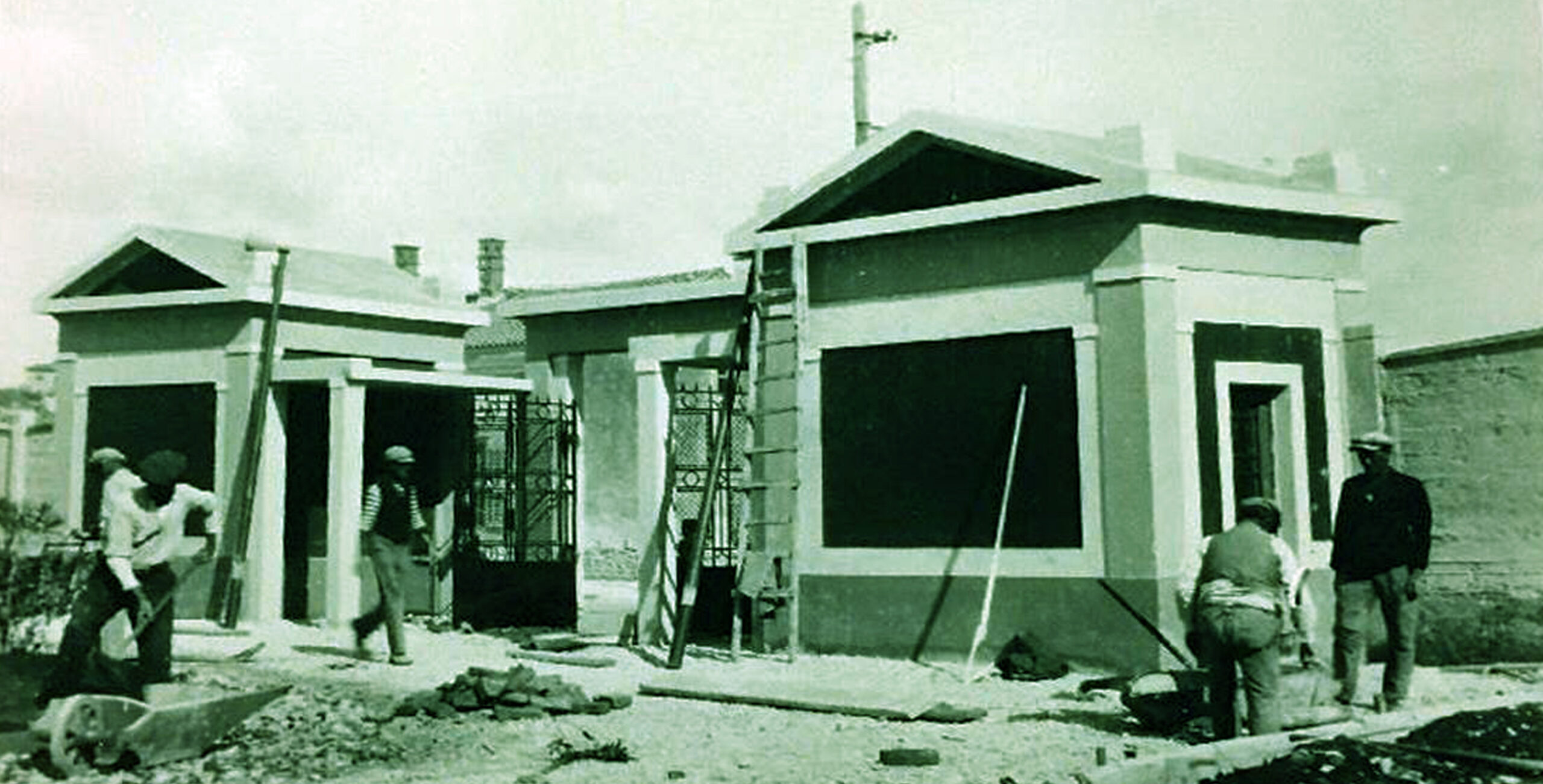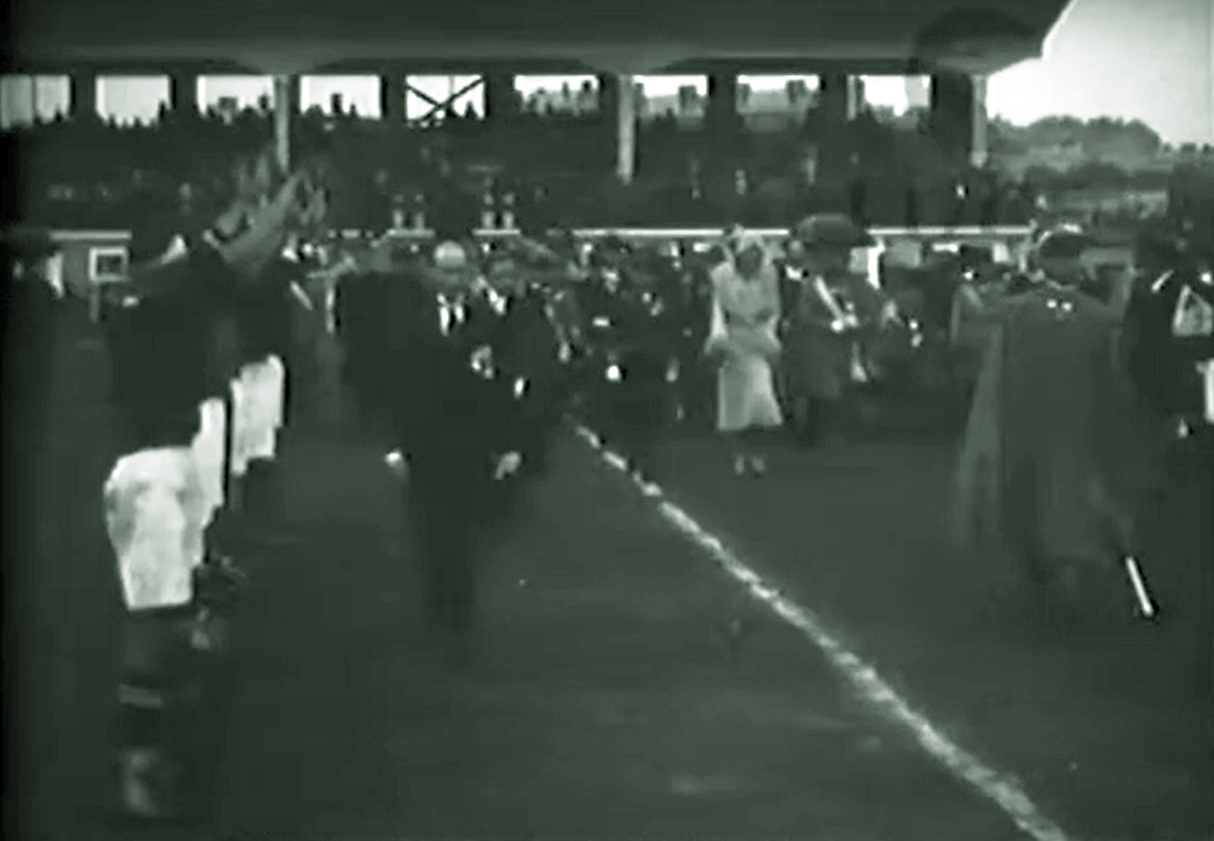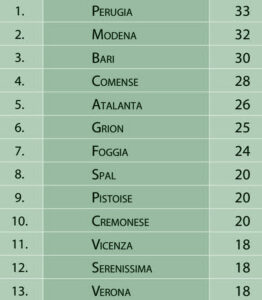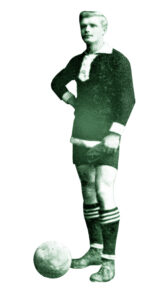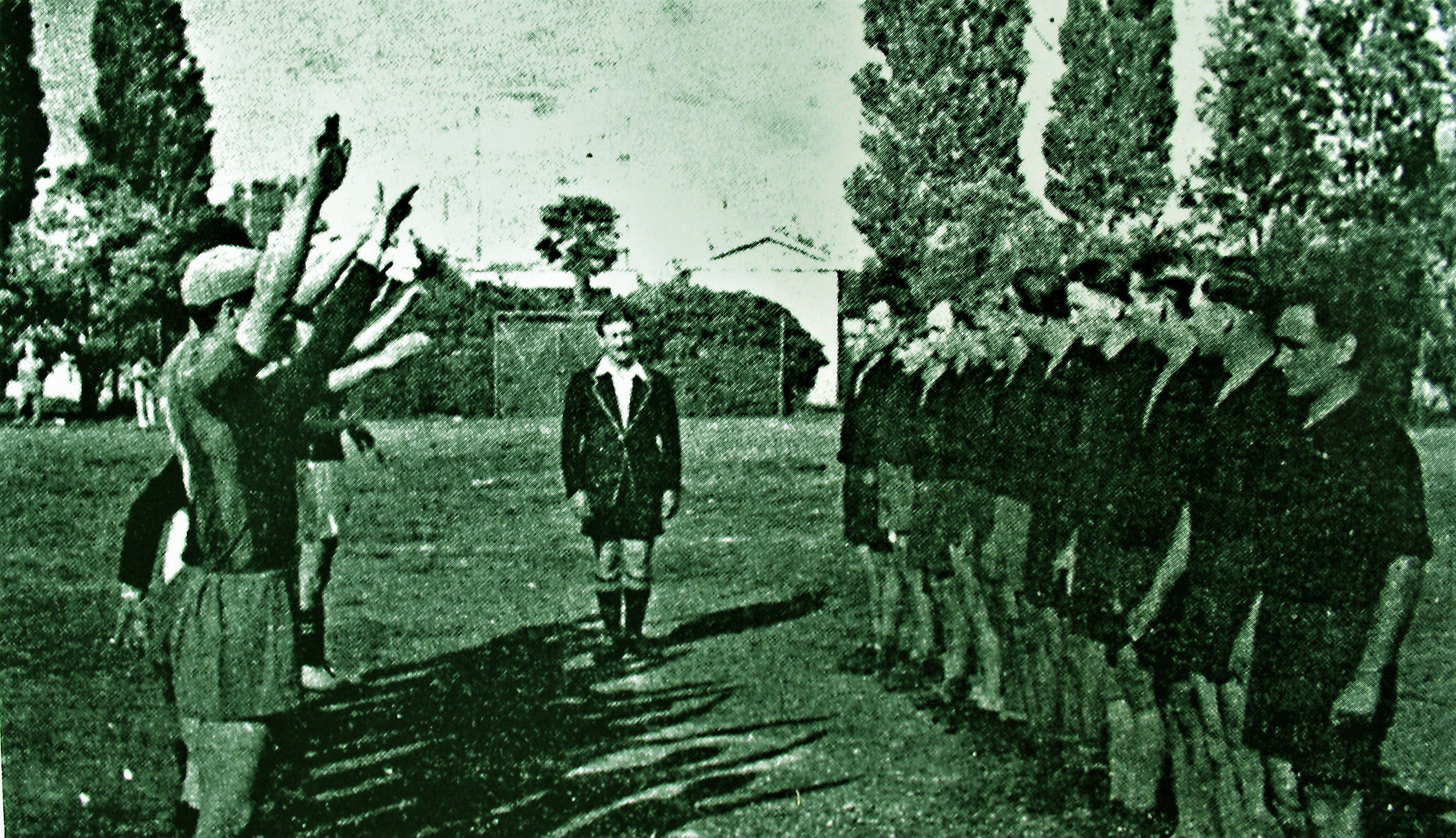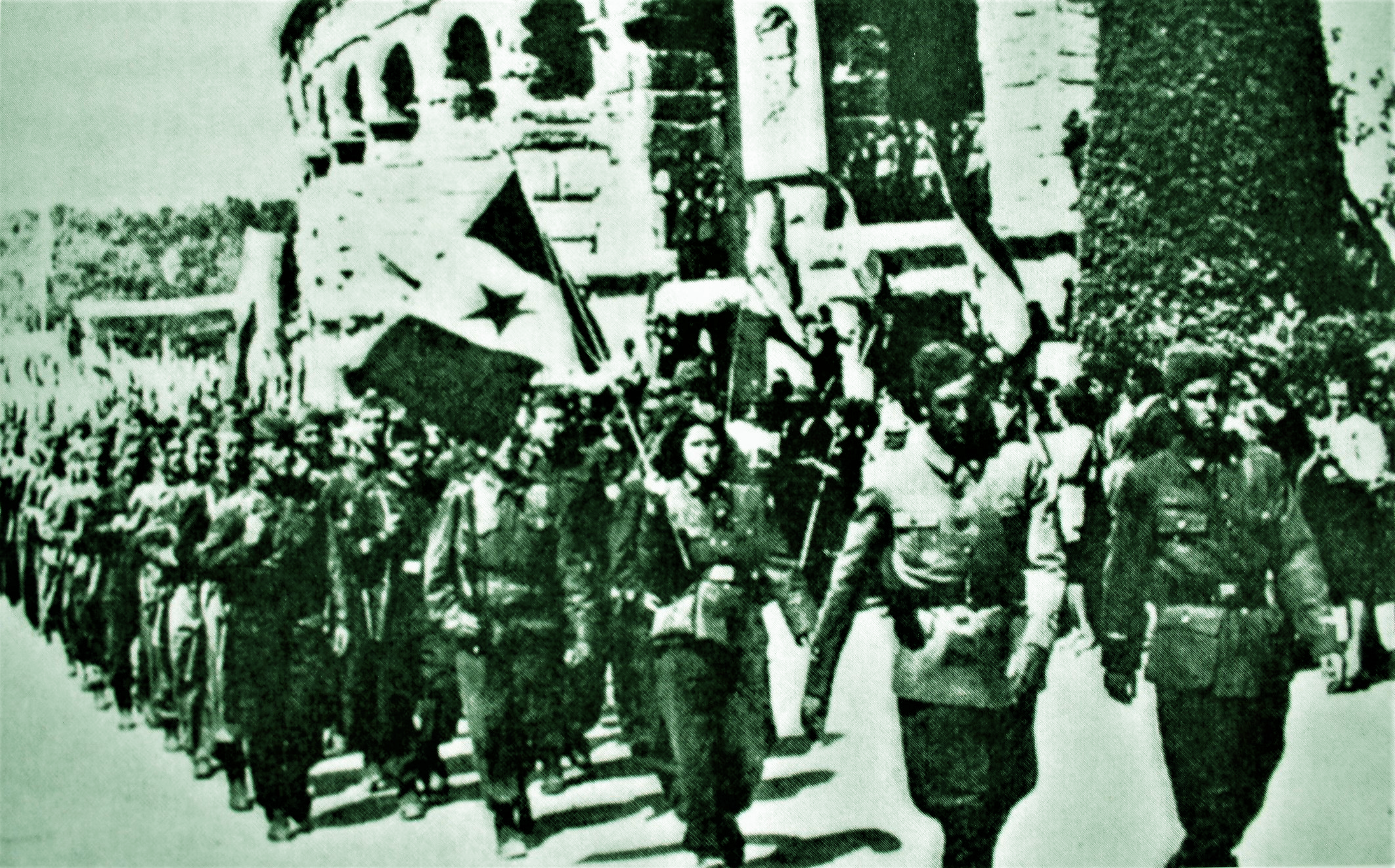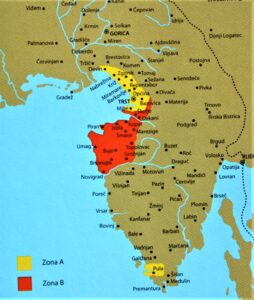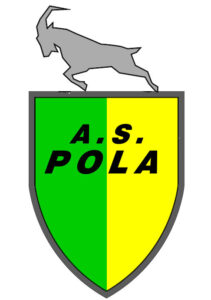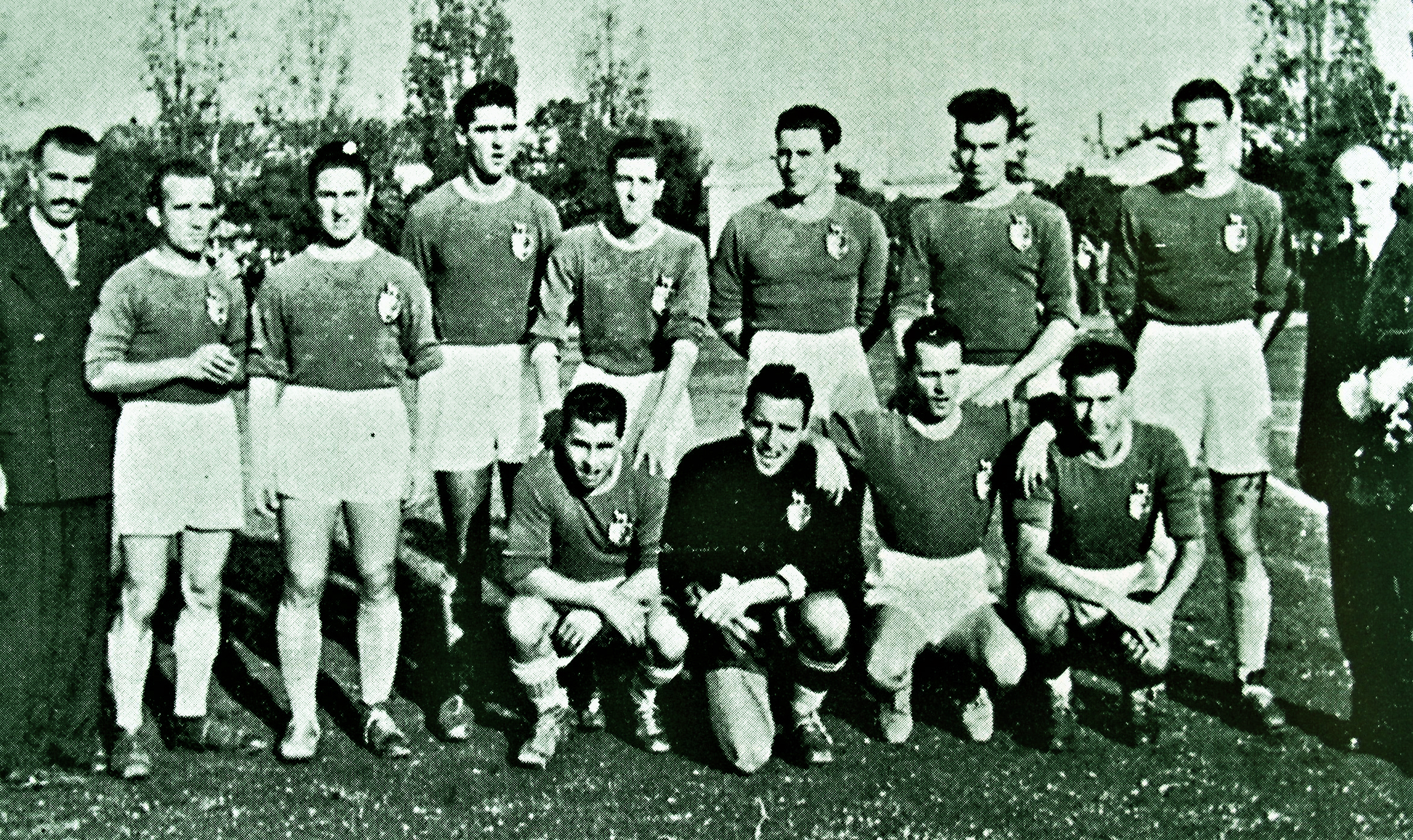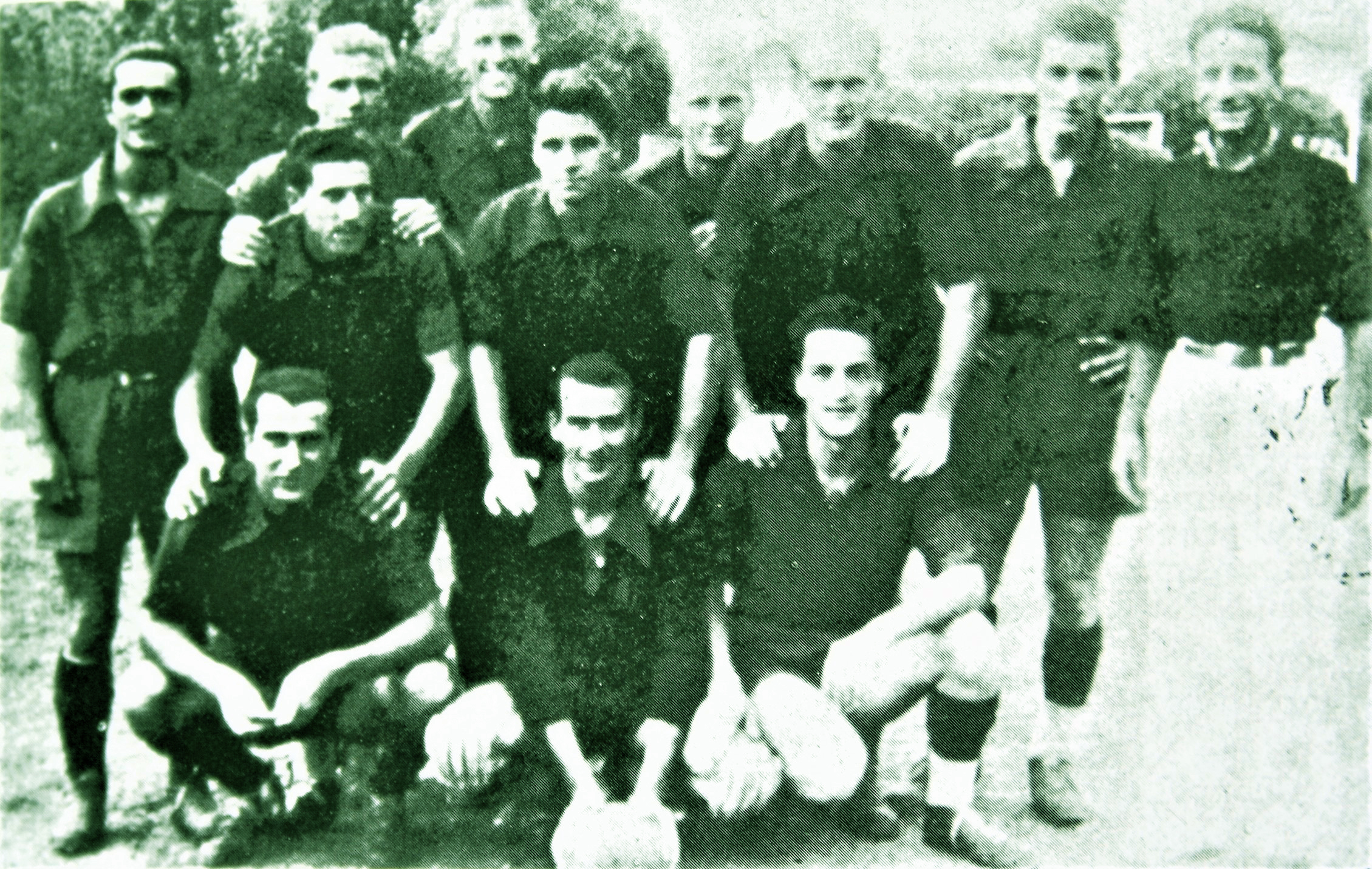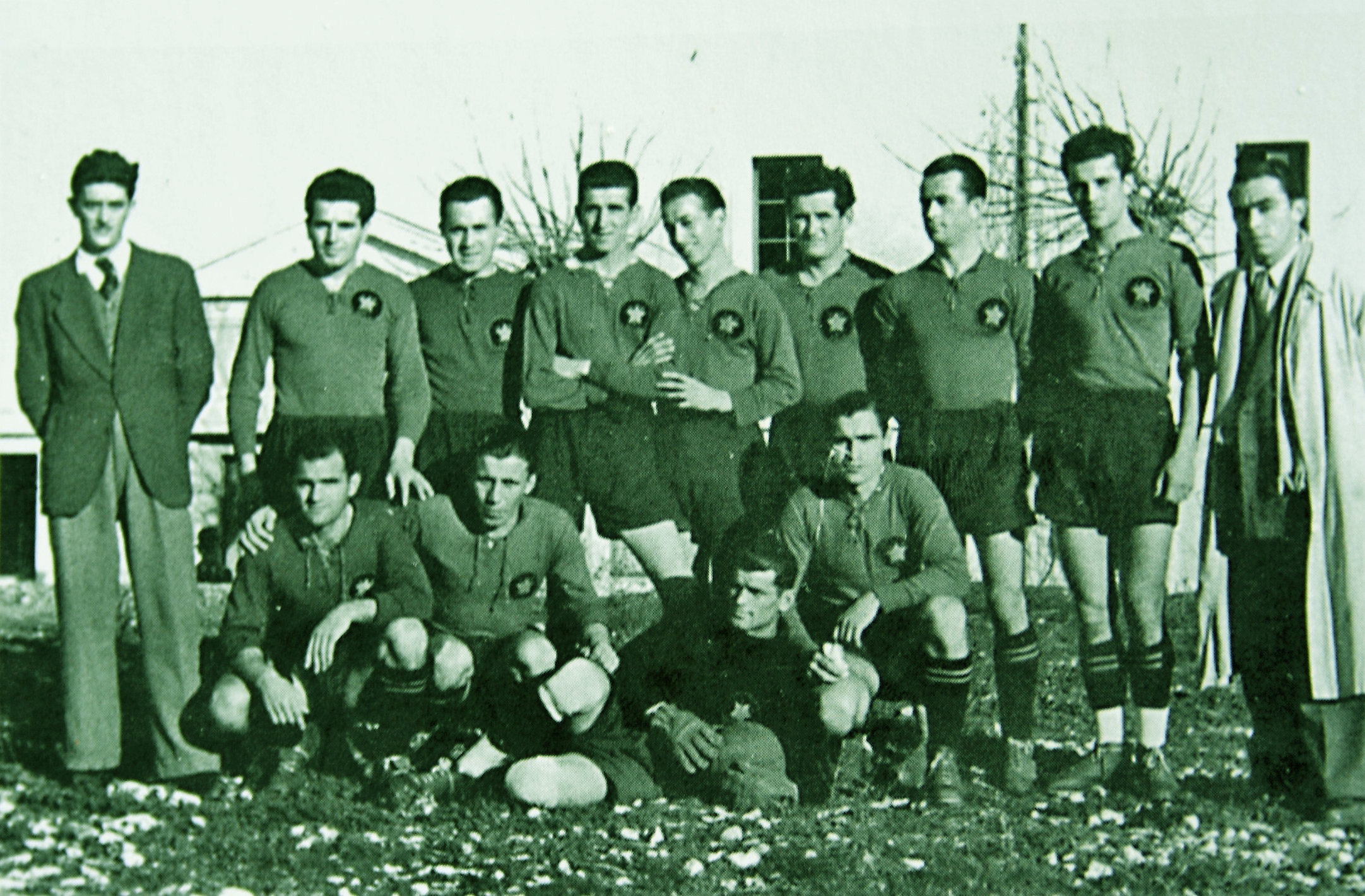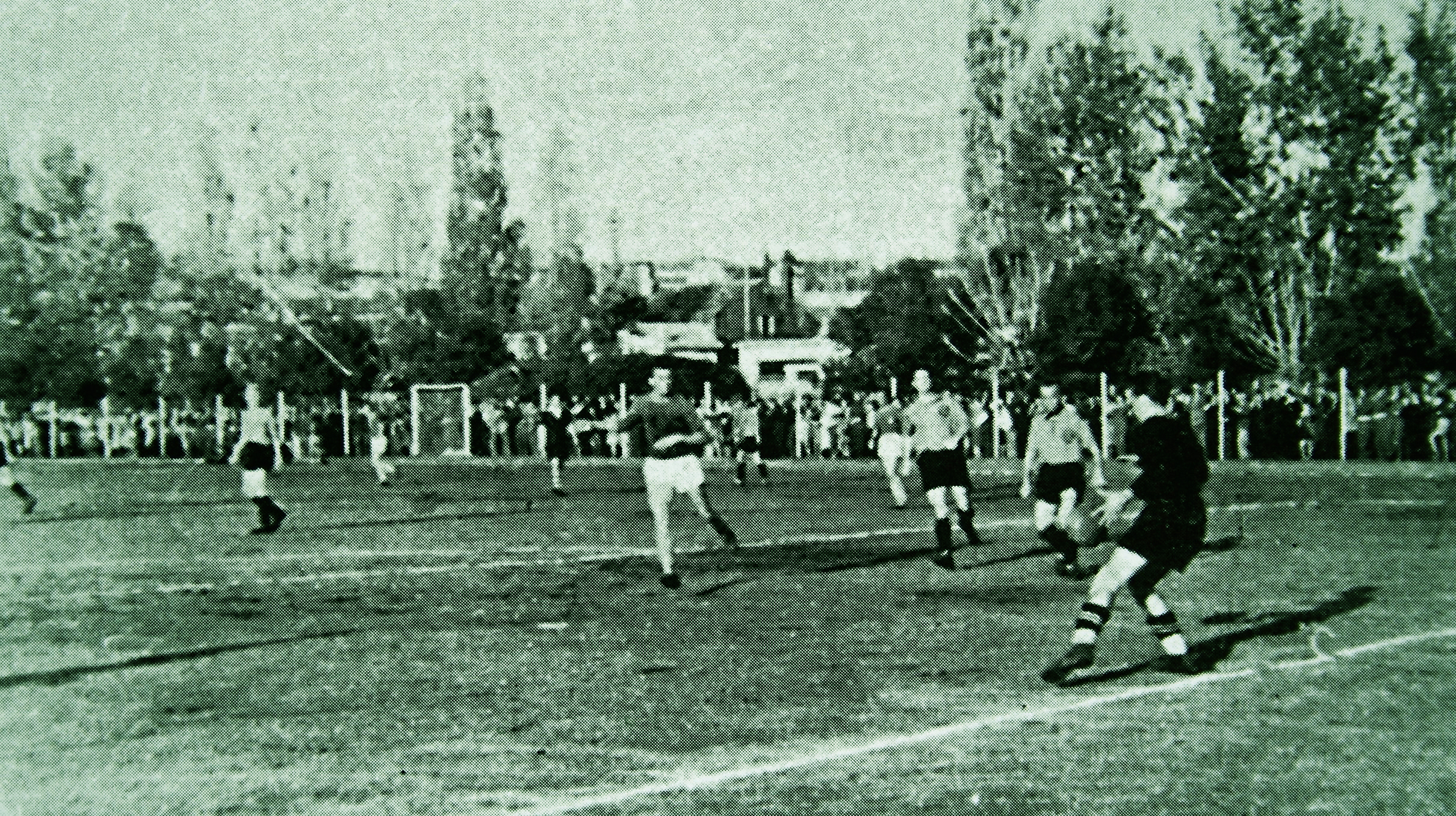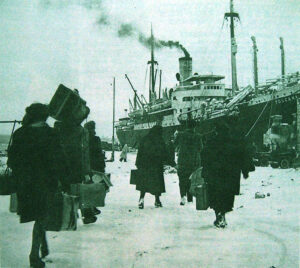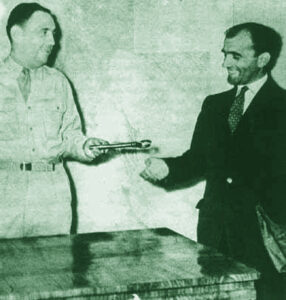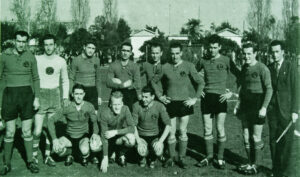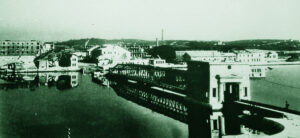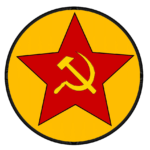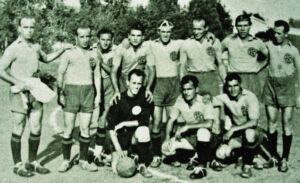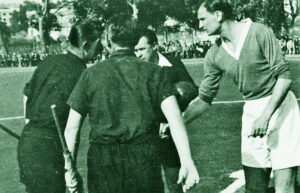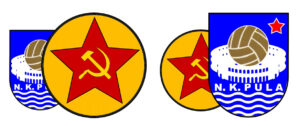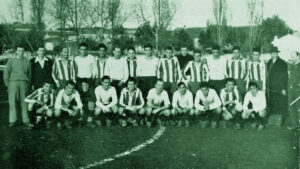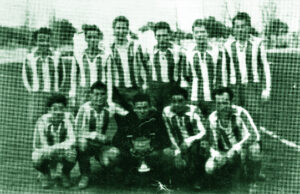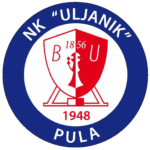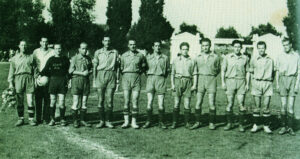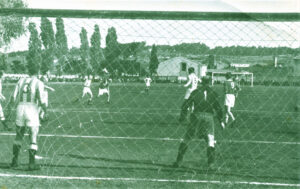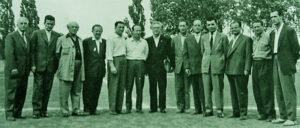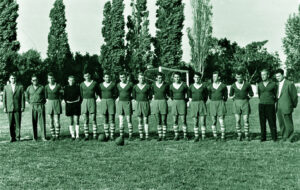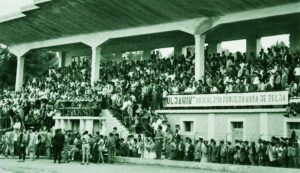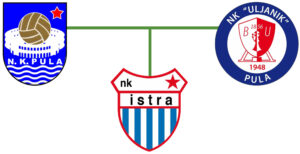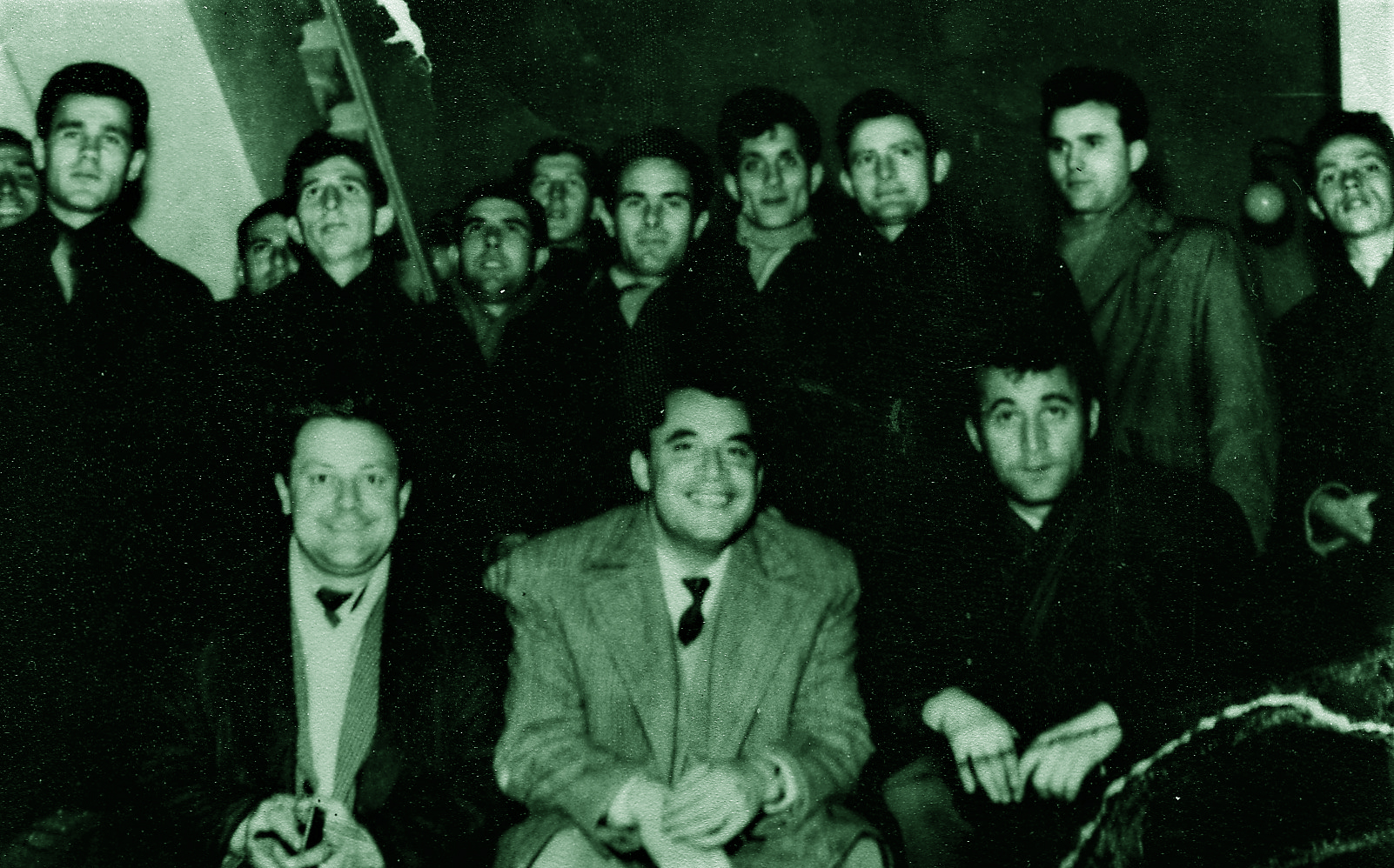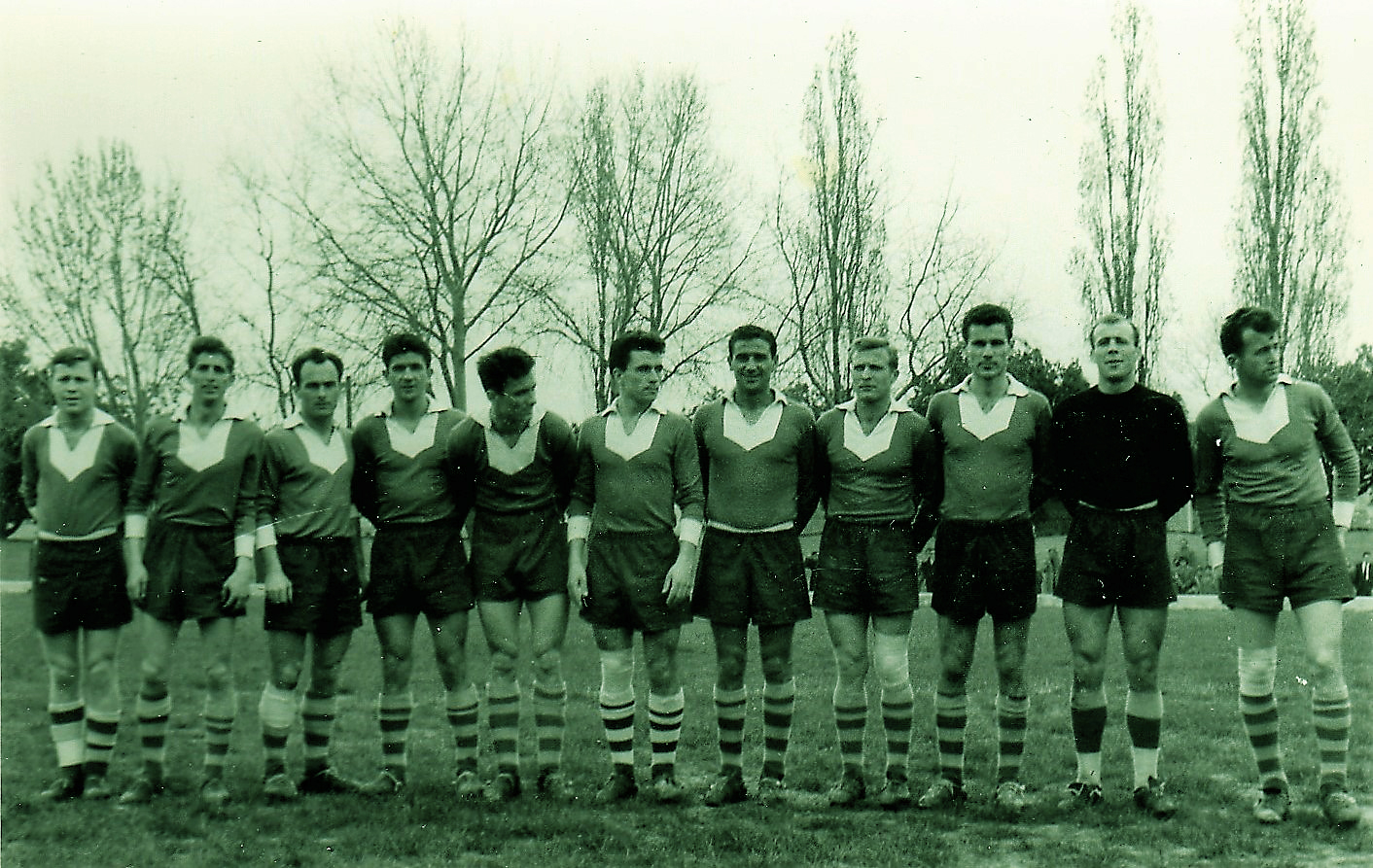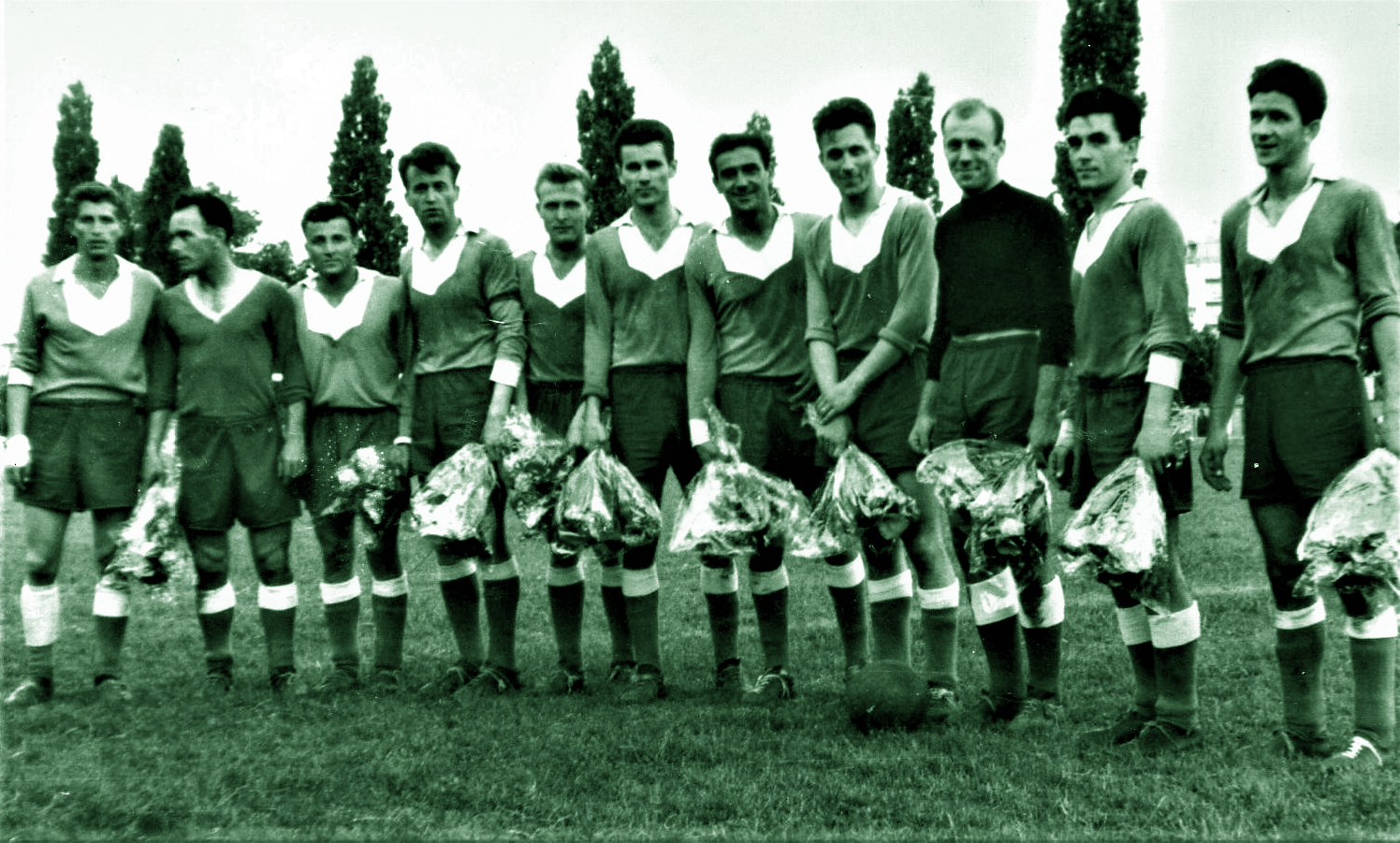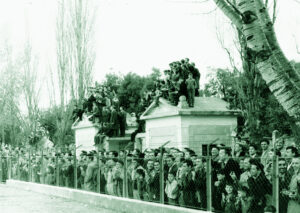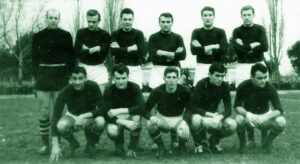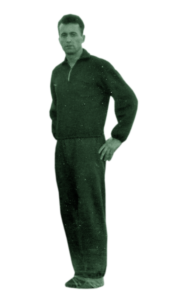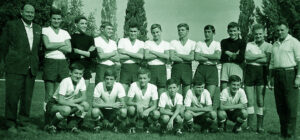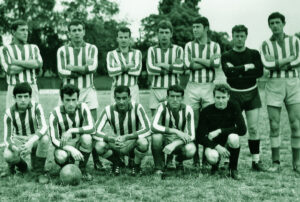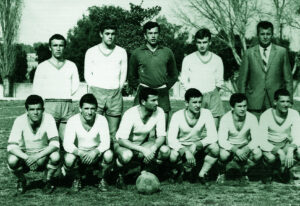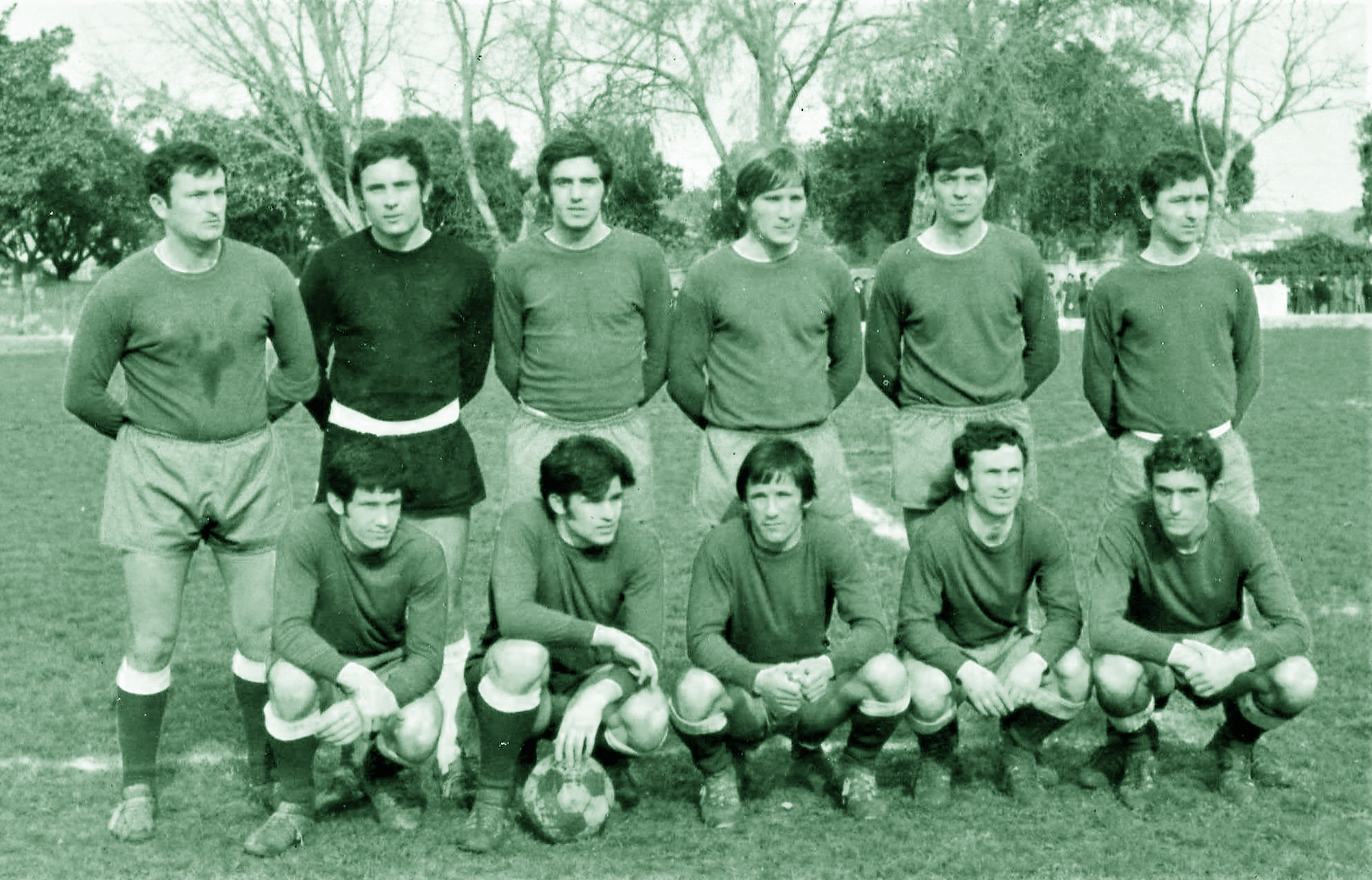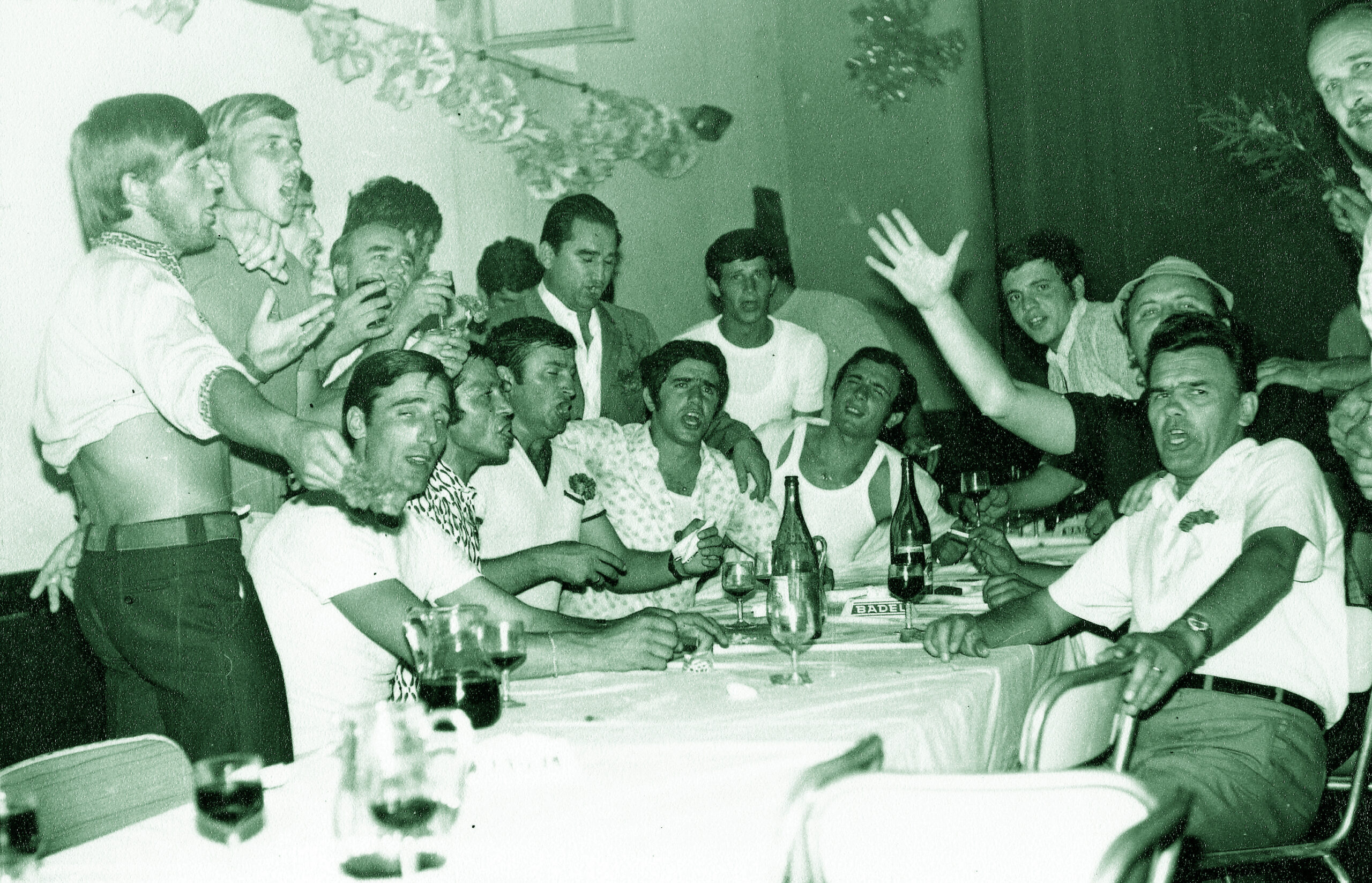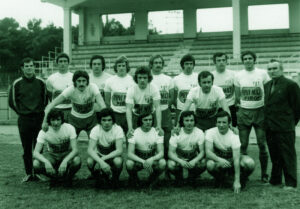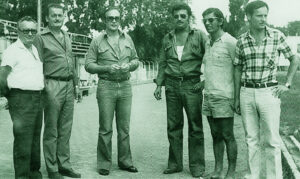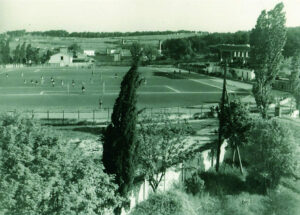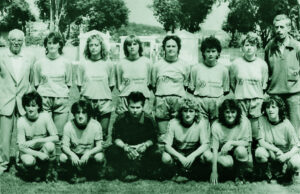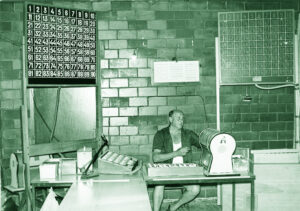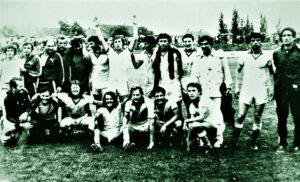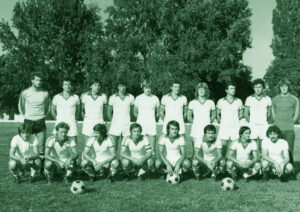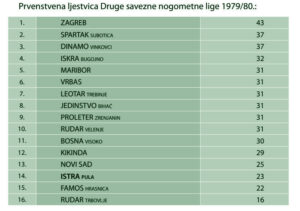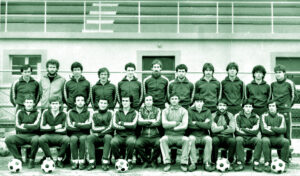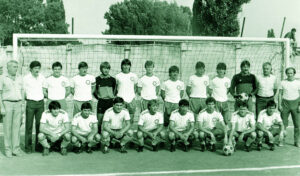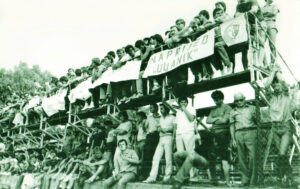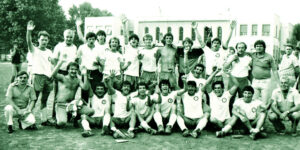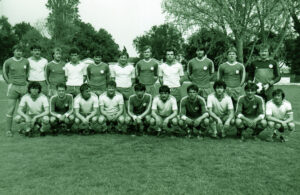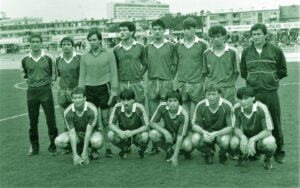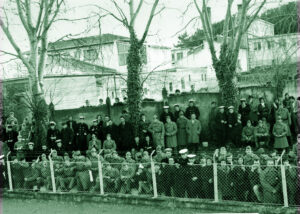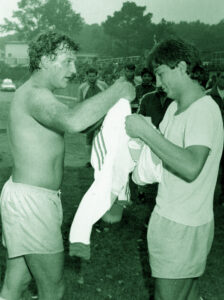Author: Anton Percan / Organizer: Nk Istra 1961

Austro-Hungarian period
After centuries in which Pula saw little progress, the second half of the nineteenth century saw the city make a great leap forward with rapid development as it took on the role of the chief naval harbour of the Austro-Hungarian Empire. Young people poured in from all parts of the multinational monarchy in search of jobs. But Pula was not just a naval base, it was also a town shared by the small native population, the newly arrived workers at the Arsenal, and the officers and enlisted men serving the imperial navy. It was in this cosmopolitan setting that Pula saw the founding of sporting associations and clubs espousing class, social and national interests.
In June of 1886 the young Natale Vareton, a member of the family that owned the quarry and land in the northeast end of the port of Pula, gathered fellow aquatic sports enthusiasts and founded Pula’s first sporting club, the Societa Nautica Pietas Julia. That same year saw young men from working class families gather at the other end of the port, at Vergarola cove, to found the Serenissima nautical club.
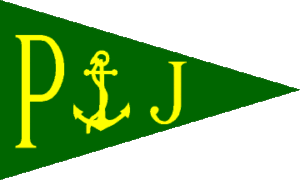
Amblem Societa Nautica Pietas Julia
Sporting organisations of Austrian officers and civil servants, and associations gathering ethnic Italians and wealthy merchants, were founded during this period, and Pula was also home to successful Croatian sporting associations espousing national equality in the Austro-Hungarian Empire.
A local chapter of Hrvatski sokol, an association promoting exercise and national self-awareness among Croats and other Slavs, was founded in Pula in 1897.
The association was led by Lacko Križ (son-in-law to Matko Laginja) and had 130 members in men’s and women’s sections.
In August of 1899 the podesta of Pula Lodovico Rizzi issued a regulation forbidding cycling on the city streets. In response the speed-loving youth of Pula founded the Veloce Club Polese later that year, primarily as a cycling club, but open to other sports.
The newly founded Veloce Club Polese also had a football section, and 1899 is thus considered the date of the founding of the first football club in Pula. Further solidifying this year as the beginning of organised footballing activity in Pula is the fact that the district administration issued a permit in August of 1899 for the founding of the Club Iris, which featured football as its most active and popular activity.
Football, of course, was played in Pula prior to the founding of the Veloce Club Polese and the Club Iris.
Pula’s many greenswards were the most suitable areas in which to play with a ragball (known to the kids in Pula as a krpenjača or balla de strassa). Besides fisticuffs, rivalries among the young boys from the town’s various quarters (Kaštanjer, Monvidal, Barake, Veruda, Šijana, Monte Paradiso, Montezaro and others) would be played out by testing their mettle at football matches.
The first matches following the laws of the game were staged at the foot of Montezaro hill, at the Exerzierplatz, a level field used to train soldiers facing what is now the Karlo Rojc Culture Centre. Going head-to-head were teams drawn from the multinational crews of boats stationed at the Austro-Hungarian Empire’s chief naval port and from among the cadets of the military engineering school (the Maschinenschule).
We find the first report concerning a football match in Pula in the 14 April 1902 issue of local newspaper Il Giornaletto di Pola. The paper reported on a match played the day before between Pula’s naval club (“locale club della marina“) and a team of players from Ljubljana and Celj (“societa sportive di Lubiana e Cilli“).
The match was played on a field that is now the site of the city stadium’s alternate pitch (the now-legendary Karbonina). It was known as the Dei sette moreri field after a nearby greensward on which mulberry trees grew (the area stretching from the current Secondary School of Economics to the temporary worker’s accommodation estate).
It was here that in 1912 the A.S. Edera football club of Pula, founded in August of 1910, would develop the city’s first proper football pitch.
The most active branch of the Associazione Sportiva Edera sporting organisation was its football club. The group drew its membership from the ranks of Pula’s working class and residents sympathetic to socialist ideas.
The day after the football grounds were opened, all able-bodied men in Pula were drafted into military service and by late July of 1914 the Austro-Hungarian Empire had declared a state of war with Serbia. War was at the doorstep and the threat to the security of the state saw a ban on many sporting and club activities.
F.C. Olimpia was one of the few clubs that did not cease its activities and at the start of the war it played a match at the Exerzierplatz pitch against a team drawn from the battleships anchored in Pula’s harbour.
In spite of the wartime prohibition on the founding of new associations and clubs, a new club did appear in Pula in 1917, the Čitaonica Croatian Football Club. After the request to found a club was turned down the club’s founder Josip Bazeli submitted a report that the local Hrvatska čitaonica (“Croatian Reading Society”) had founded a football club, which presented the district administration with a fait accompli.
The members of the club were young men from Premantura, Vinkuran and Medulin.
Period of Italian Government
By late November of 1918, soon after Italian troops had occupied Pula, the Secession café (at the site of the present-day Postal Savings Bank) was the venue for a gathering of members of the youth wing of the fascist party that had come into the Istrian peninsula (the Fascio Giovanile Istriano). The group’s founder Luigi Bilucaglia established a sporting club called the Fascio Giovanile Giovanni Grion.
The newly founded club was named after Giovanni Grion, a Pula resident born in 1890. At the start of the First World War, he deserted the army of the Austro-Hungarian Empire and joined the Italian military as a volunteer. He died during fierce fighting near Asiago in June of 1916. After the war he was celebrated among Italian nationalists in the Istrian peninsula as a hero.
Just a few days after the founding of the F.G. Grion club, in early December, youth in Pula who opposed the pro-fascist Grion club revived the Veloce Club Polese association and founded clubs based on residence in city quarters, social status, or national orientation. Thus, by the end of 1919, Pula had seen the founding or revival of the Giovani Calciatori Polesi, Calcio Audax, C.S.I. Polese, C.S. Intrernazionale, Alievi Sportivi Polesi, U.S. Primavera and other clubs.
Those opposed to the pro-regime and pro-fascist Grion association gathered at the Dei sete moreri football grounds a few hundred metres from the Grion pitch. In November of 1921 working class Pula residents, inclined towards socialism, joined former players and fans of A.S. Edera to revive the activity of the club, which had been shut down nine years earlier by the Austro-Hungarian authorities.
Every match between city rivals Edera and Grion was charged with an atmosphere of opposing political views, both on the pitch and between the players, and even more so in the packed bleachers, with matches typically ending with police interventions to separate the quarrelling fans.
As the city’s leading club, A.S. Edera played its final match in March of 1926. Fascist thugs raided the Edera premises, destroying the club’s equipment, and the political authorities—having failed to force a merger with the Grion club—simply banned Edera on claims of “enemy and subversive activity”, shutting down the club favoured by Pula’s working class and opponents of the regime.
With the clampdown having put A.S. Edera out of action, the F.G. Grion club assumed the role of the city’s top football club.
PULA´S FOOTBALL TEAMS BETWEEN THE TWO WORLD WARS
Pula mayor and F.G. Grion president Luigi Bilucaglia issued a proclamation to the city’s residents calling on them to support the erection of a sports centre to provide athletes in the city with ideal conditions in which to achieve greater success and to spread the glory of Pula’s sports achievements. The stadium design was produced in the municipal technical bureau by Pula architect Guido Brass.
The city’s stadium was opened on 28 October 1931, just short of two years from the start of construction, to mark the 19th anniversary of the fascist “March on Rome” with a match pitting Grion against Triestina in the presence of the Prince of Piedmont and the princess Marie-José.
Pula’s 8,000-capacity Campo del Littorio stadium featured a central grandstand with a structurally demanding reinforced concrete canopy. It was part of one of the most modern sports centres in Italian-held territories of the time, and included the Casa Balilla (now the Braća Ribar centre), with a sports arena, a smaller sports ground and two tennis courts.
1932, its first season of play at the new stadium, saw the Grion side qualify for Italian Serie B league competition. Two years later, during the 1933/34 season, the squad clinched the number six spot in the Serie B league, the best ranking Pula footballers saw in the period between the two world wars.
Vittorio Zucca was Pula’s most successful athlete in the period between the two world wars. A versatile athlete, Grion footballer, and one of the pioneers of football in Pula, he was also an Italian record holder in the 100- and 200-metre dashes. He competed in the Olympic Games in Antwerp in 1920 and Paris in 1924.
The Grion squad played its final match in February of 1945 against a team drawn from the local German garrison.
The last wartime match was played in mid-April 1945, just some twenty days ahead of the city’s liberation, featuring a squad drawn from Pula footballers playing a team drawn from German unit stationed at the Muzil barracks.
Partisan units enter Pula
On 3 June 1945, just some twenty days after Partisan units entered the liberated city, Pula saw its first post-war match between the Antifascist Youth of Pula squad and a team named in honour of celebrated Pula footballer Aldo Fabbro. This match was preceded by a warm up match featuring a team named after Pula’s earliest football club, Iris, and a team drawn from the veterans of the Partisan’s 43rd Istra Division.
An agreement hammered out among the great powers saw the border between Italy and Yugoslavia drawn out based on ethnic composition, with the Istrian peninsula divided into two zones: Zone A included Trieste and Pula and was under Anglo-American control, and Zone B was under the administration of the Yugoslav army. Allied forces entered Pula on 16 June, with the Yugoslav army units withdrawing to the demarcation line about five kilometres from the city.
Associations and sports clubs were formed along lines of political affiliation to Yugoslavia and Italy.
With the Anglo-American administration having shut down the pro-fascist and compromised Grion club, a group of young men still hoping to see Pula annexed to Italy set up the Associazione Sportiva Pola (A.S. Pola) club in August of 1945.
In early September of 1945 the Association of Partisans of the Giulia Region (Associazione Partigiani Giuliani) set up the APG sports club headed by popular sportsman Edi Rajković.
The Anglo-American military administration did what it could to move the tense relations and conflicts between the followers of opposed political views off the streets of Pula and channel the emotions to the football pitch, organising frequent matches pitting A.S. Pola against U.S. Operaia, with British and American troops standing between the frequent conflicts between the vying supporters.
One of the most bizarre events in Pula’s history, certainly not only as it relates to football, took place just four hours after the tragic explosion of ordnance at Pula’s Vergarola beach that took 65 lives and injured over a hundred Pula residents.
That day, 18 August 1946, saw a return match played at the city’s stadium for promotion to the Yugoslav 1st League pitting Pula’s USO squad and the Kvarner team out of Rijeka.
Italian émigrés, including a number of footballers, had begun moving out of Pula even before the governments of Italy and Yugoslavia signed a peace treaty on 10 February 1947, based on the conclusions of the Paris Peace Conference, which saw Pula integrated into Croatia, then part of the Yugoslav federation.
APG (Associazione Partigiani Giuliani) in 1945
Standing: Livio Tessaris (coach), Gino Cherstaldi, Coslian,Zahtila, Viscovich, Bosazzi, Zuccon, (unknown), Edi Rajković (manager): squatting: Bertolanza, Sauer, Bacigalupo, Budim
The USO v. Kvarner match was played just four hours after the Vergarola tragedy
The commander of the Anglo-American forces hands the keys of the city to Ivan Motika on 15 September 1947
With both the parliament of Yugoslavia and Italy having ratified the peace treaty by September of 1947, the way was clear for British and American troops to withdraw from Pula, followed on 16 September 1947 by unification with Croatia and the Yugoslav federation.
U.S. Operaia in 1947
Standing: Buich, Devescovi, Chiraz, Smolizza, Richter, Doria, Lui, Pericin L.; squatting: Pericin T., Brazzano, Pacor
It was just a few days later that Pula’s USO club and the newly founded NK Proleter club joined play in the 5th football zone of league competition covering the Istrian peninsula and Rijeka area.
Destroyed facilities on Uljanik island
With life back to normal and the Uljanik shipyard back in operation, the Proletarian Aid programme saw shipyard workers arrive from Italy’s Monfalcone to assist in the rebuilding of the destroyed plant and equipment. Many were active footballers, with players Ferluga, Tripodi, Revelant, Richter, Doria, Feghitz, Toffolo, Lui and others entering the line-up of the USO squad.
Period of Yugoslavia
NK Proleter was founded in September of 1947 with the return of the Pula labour brigade from the Šamac to Sarajevo railway line construction sites. Its line-up included former players of Pula’s APG club.
At its first meeting of 24 November 1948, held at the Partizan movie theatre, the municipal physical education federation established the Pula Sports Association and merged the USO and Proleter clubs to form NK Pula.
Just five days after its founding, on the occasion of Republic Day, Pula played host to Zagreb’s NK Dinamo for a friendly match with the newly created NK Pula and its line-up of the top players of the former USO and Proleter squads.
As the Croatian league season progressed most of the club’s players followed many other Pula residents—dismayed with the rigid attitude of the communist regime—and emigrated to neighbouring Italy.
Faced with this reality Pula’s officials opted to shut down NK Pula and in July of 1947 revived the NK Proleter club they had shut down a year earlier.
In 1948, a few months after the departure of the joint British-American administration, the labour union at the Uljanik shipyard founded a sporting association with sections for basketball, volleyball, athletics, boxing, angling and football. Among the association’s founders were former Edera and Grion footballers Angelo Dicovich and Giordano Terlon, who was a player and coach with this squad through to 1951.
The 1950/51 season saw NK Uljanik join the competition in the Rijeka regional football division, where city rival NK Pula was already playing.
Thanks to stable funding, the Uljanik shipyard sports association became the principal driver of quality sports in Pula, propelling NK Uljanik to the role of the city’s top football club, aiming to represent the city at federal level competition.
NK Uljanik in 1948
First and fourth from the left: the founders of the association and former Grion and Edera players Angelo Dicovich and Giordano Terlon
Matches between city rivals NK Pula and NK Uljanik were marred by foul play on the pitch and rowdy behaviour on the bleachers between opposing fans, which reflected the actual divisions in the city between the “locals” of NK Uljanik and the “outsiders” of NK Pula.
A derby match between city rivals NK Pula and NK Uljanik
After clinching the Rijeka-Pula football division title NK Uljanik faced Branik of Maribor in the deciding qualification match for promotion to the Federal Second League. A slim win was not enough to overcome the nil–2 loss in the first leg of the fixture and a Pula team again failed to land a spot in the Second League.
There was disappointment in Pula after yet another unsuccessful qualification bid to land a team in Second League competition. Society figures and policy makers reacted quickly: just a day after the match the general assemblies of both NK Uljanik and NK Pula met with a single agenda item: to merge the two clubs.
The building now home to the Croatian Veterans’ Centre was the venue at 6 o’clock in the afternoon of Tuesday, 1 August 1961, for the founding meeting of NK Istra, presided over by Antun Babić, president of the People’s Committee of Pula. Mijo Pikunić was appointed the first president of the club, with Ivan Cukon and Edo Girardi, presidents of the merged clubs, serving as his vice-presidents.
NK Istra’s Second League matches drew broad interest among the city’s residents, with packed grandstands at Pula’s stadium.
In 1963 Ante Blašković, the former coach of the NK Pula club and a football enthusiast, founded NK Tehnomont, as a club sponsored by the company he was the director of. He also set up a football school that would produce the most talented generation of Pula footballers and that would be associated with the greatest achievements of Pula football in the coming two decades.
After three years out of action NK Uljanik was revived in 1964. Bolstered by former NK Istra players Giljanović, Mingon and Radošević, they clinched the title in the Pula regional football federation in the 1967/68 season and secured a bid for promotion to the Rijeka-Pula division.
After three years out of action NK Uljanik was revived in 1964. Bolstered by former NK Istra players Giljanović, Mingon and Radošević, they clinched the title in the Pula regional football federation in the 1967/68 season and secured a bid for promotion to the Rijeka-Pula division.
With NK Istra relegated out of the Second League almost all the first line players left the club, leaving coach Aldo Drosina to kick off the 1967/68 season of the Rijeka-Pula division with an untried squad drawn from a fresh batch of juniors out of NK Tehnomont and another Pula squad, NK Avijatičar.
Both NK Istra and NK Uljanik opened the 1968/69 season training to compete in the Rijeka-Pula division. A reshuffling, however, of the competition system replaced the two divisions of the Federal Second League (East and West) with four divisions (East, West, North and South), and NK Istra was incorporated by a policy decision into the western division of the Federal Second League, where it only saw one season of play.
As the second placed club in the Rijeka-Pula division in the 1969/70 season, NK Istra had another bid at securing promotion to the higher league through qualification fixtures, but Jedinstvo of Bihač and the Zadar team proved more fortunate.
In the 1969/70 season Rijeka-Pula division competition saw NK Istra joined by Pula clubs NK Uljanik and NK Staklar, with derby matches between city rivals returning for the first time since 1961.
In the 1970/71 season NK Istra faced off against Radnik of Velika Gorica for a spot in the Federal Second League.The installation of new turf at Pula’s stadium saw the return leg of the qualification fixture played in Rovinj. NK Istra won the match in a penalty shootout to secure promotion to the Second League.
Another reshuffling of the competition system (replacing the four-division system with a two-division system in the Second League) saw NK Istra, near the bottom of the league rankings, open the 1973/74 season in the Croatian League.
After an eight-year absence Željko Žmak returned to the club at the post of president. He and the new management team launched the construction of a club restaurant to the north side of the city’s stadium.
Raffles staged at the club restaurant proved to be a reliable source of club funding and over the coming decade would spread to other Pula sports clubs as a dominant financing model.
In the early 1970s football coach and enthusiast Tonči Blašković founded ŽNK Staklar, one of the first women’s football clubs in the broader region.
NK Istra players celebrate after the match in Slavonski Brod on 17 June 1979
Standing: Ostović, Jadreško, Bilić, Duboković, Božić, Šugar, Smajla, Bolković, Medak, Capolicchio, Antunović (management), Kovačević, Rosignoli (coach); squatting: (unknown), Bogojević (physiotherapist), Letica, Banjac, Silić, Pastrovicchio, Orlić
Having secured the top spot in the Croatian Football League during the 1978/78 season NK Istra secured a qualification bid for promotion to the Federal Second League that saw it face BSK of Slavonski Brod. A 3–1 home win on the first leg of the fixture and a slim loss of 2–3 at the away game saw NK Istra once again enter the ranks of the Federal Second League.
NK Istra closed out competitive play in the Federal Second League in the 1979/80 season holding the number thirteen spot in the rankings, not enough to avoid relegation to the lower division.
Independent Croatia
Unhappy with the club’s showing and relegation out of the Second League, the new NK Istra management opened the 1982/83 season by hiring celebrated international coach Josip (Joško) Skoblar. In spite of this reinforcement on the bench, the Pula squad wound up the season at the middle of the rankings in the Croatian Football League.
More than twenty years after the match in 1961 that pitted NK Uljanik against Branik of Maribor, Pula’s football fans had another opportunity to unfurl their banners in support of the Uljanik squad. The deciding match for the regional league title saw the Uljanik side defeat NK Grobničan and secure a spot in the Croatian League alongside Pula’s leading club NK Istra.
NK Uljanik in 1983 ahead of the match with NK Grobničan
Standing: Mile Koljančić (club president), Valić, Šverko, Pavlović, Ibriks, D. Koljančić, Jeromela, Vretenar, Savić, R. Matteoni, Kuzman, Milović (club logistics), Ivan Pržiklas (coach); squatting: Maretić, Beljan, Jelovac, Brezac, Crevatin, Halilović, Orlić, Ristić
The second half of the 1980s saw a series of unsuccessful qualification bids by NK Istra, following competitive play in the western division of the Croatian Football League, to break back into higher division competition. After the 1985/86 season Pula’s efforts were thwarted by NK Zagreb, and the following season by BSK of Slavonski Brod.
Having played his final match in November of 1988, Branko Bubić presented his NK Istra jersey to the young Elvis Scoria, marking a change of the guard in Pula’s football history.
In spite of the lack of headway among Pula’s clubs in the late 1980s, Pula football fans were able to watch top league squads of the former federation in action. They increasingly chose Istra County as the venue for pre-season training, part of which included matches with NK Istra. These matches drew significant stadium attendance, especially among the soldiers stationed at the many barracks in Pula eager to watch their favoured First League sides.
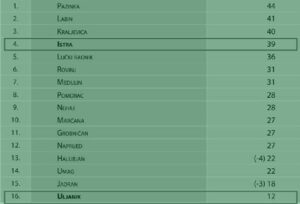
The rankings of the Croatia League western division in the 1990/91 season
1990/91 was the last season of competition in the fold of the now defunct Yugoslavia. Before it would be included by a policy decision in independent Croatia’s First League, NK Istra competed in the western division of the Croatian League along with NK Uljanik.
NK Istra played its last competitive match in the former federation in Marčana to a 4–4 tie.
On 25 June 1991 Croatian Parliament severed ties with the Yugoslav federation and declared the country’s independence. The former federation’s last military units left Pula on 16 December of that year. Croatian independence and the breakup of the Yugoslav federation brought great change to all areas, including sports. The federal football league and its divisions ceased to function, and the Croatian Football Federation established a national league of twelve clubs that included NK Istra.
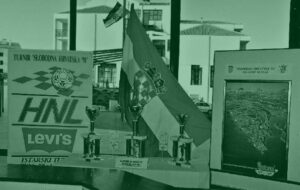
The Free Croatia 91 tournament in Istra County
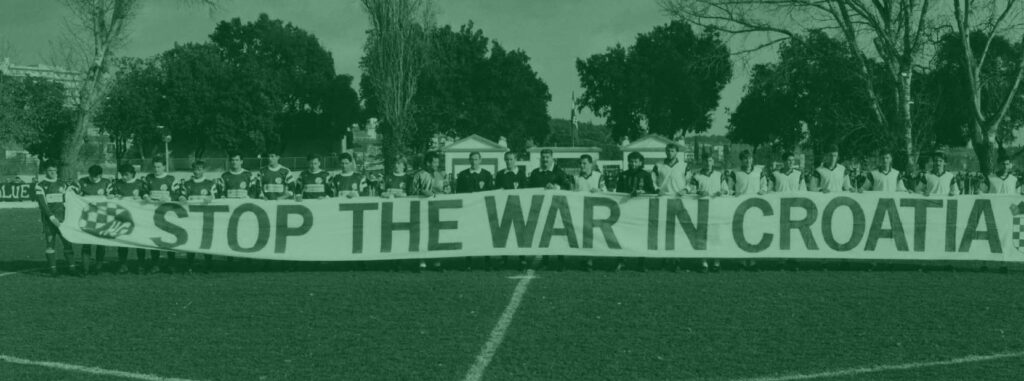
Zagreb’s HAŠK Građanski and NK Istra ahead of the 1st Croatian championship season in 1992
The first football championship in independent Croatia kicked off in February of 1992. NK Istra played its opening First League match with Hajduk of Split. Hajduk won 3–1 , with striker Igor Pamić scoring NK Istra’s historic first goal in the league.
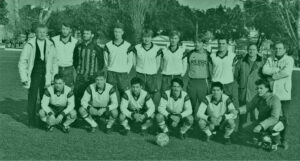
NK Istra in 1992
Standing: Aldo Drosina (coach), Pamić, Piplica, Černjul, Dadić, Knežević, Ibriks, Popović, Scoria (coach), Dr Viliam Bilić (team physician); squatting: Steinbruckner, Mujanović, Lasić, Eklić, Resan, Korać (assistant coach)
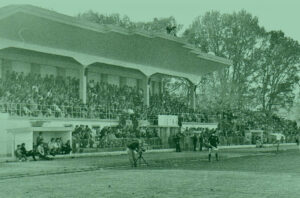
The first direct television broadcast from the Pula stadium featured the 1992 NK Istra v. NK Hajduk match
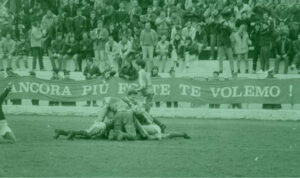
Players and fans celebrate a win over Hajduk in 1992
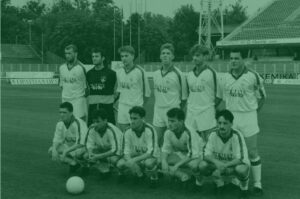
NK Istra at Zagreb’s Maksimir stadium in 1992
Standing: Pamić, Piplica, Dadić, Sušić, Knežević, Popović;
squatting: Piutti, Lasić, Raković, Jurić, Eklić
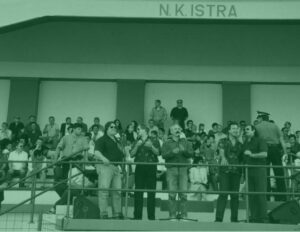
The venerable Anelidi band entertained fans during the halftime show
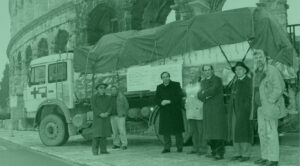
NK Istra organised to bring humanitarian aid to Pula during the Homeland War of independence
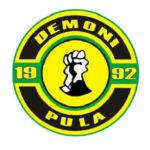
Demoni logo
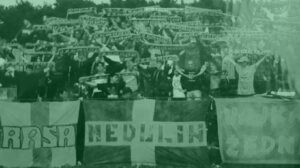
The Demoni fan club was founded in 1992
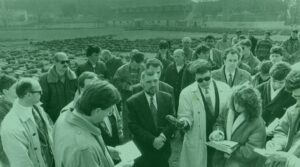
13 March 1993; Parliament Speaker Stipe Mesić opens Phase 1 construction work on Pula’s new stadium
Construction of a new stadium in the city was launched in March of 1993; Pula’s First League squad moved its matches to the Valkane Sports Centre and the SRC Uljanik stadium at Veruda.
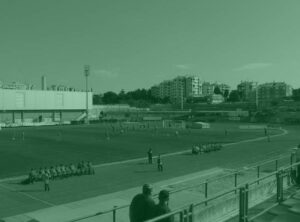
The Valkane Sports Centre
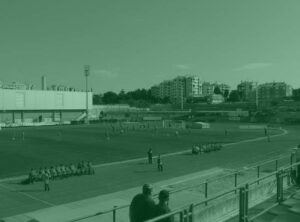
The SRC Uljanik pitch at Veruda
NK Istra sported its new colours at a match played with NK Rijeka on 20 August 1993. The blue dress worn by the Pula squad since the club’s founding in 1961 was replaced by the yellow and green colours inspired by Pula’s historical coat of arms.
The first phase of construction work on the new stadium was completed on 9 April 1995. Pula footballing legend Aldo Drosina was given the honour of cutting the ceremonial ribbon and taking the honorary first kick from the centre spot. Eight years later, in 2003, the stadium was officially named in Drosina’s honour.
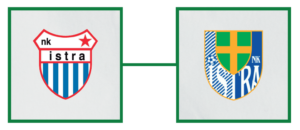

Aldo Drosina opens Pula’s stadium
The Croatian national team played its last match ahead of the World Cup in France in Pula
with the Slovakian representation
NK Istra was relegated out of the First League at the close of the 1996/97 season as the second-to-last squad in the rankings. Two seasons later, in 1999, Pula again clinched a First League spot, this time not thanks to a policy decision, but rather its play on the pitch.

NK Istra in 1998/99
Top row: Petrović (goalkeeper coach), Bilić, Kontešić, Peršić, Petrović, Kitonić, Ostović, Šteko, Bogojević (physiotherapist), Rosignoli (assistant coach), Bubić (club secretary); middle row: Milevoj, Panić, Žiković M., Jurić, Momčilovski, Kurtović, Basta, Černjul, Osmanović, Božac, Mofardin; seated: Čižmarević, Miloš, Dobrić, Bagavac, Mladen Ivančić (club president), Dragan Simeunović (coach), Vlado Orlić (club director), Raković, Alibašić, Miletić, Cukon M.
Belišće, 12 June 1999: players and fans celebrate a victory
NK Istra was relegated out of the First League at the close of the 1999/2000 season, finishing on the second-to-last rung.

NK Istra in 2001/02
Top row: Bogojević (physiotherapist), Peteh, (unknown), Pavletić, Lokvančić, Androšić, Kolić, Šehić, Ivković (assistant coach); middle row: Željko Petrović (goalkeeper coach), Ugrčić, Šteko, Stošić, Osmanović, Pajković, Buždon, Horvat, Ostović; seated: Rivić, Bernobić, Ružić, Bertoša (club secretary), Mirsad Omerhodžić (coach), Mladen Ivančić (club president), Budicin, Šuran, (unknown)
A homecoming at Pula’s market celebrates promotion to the First League following the away game in Belišće
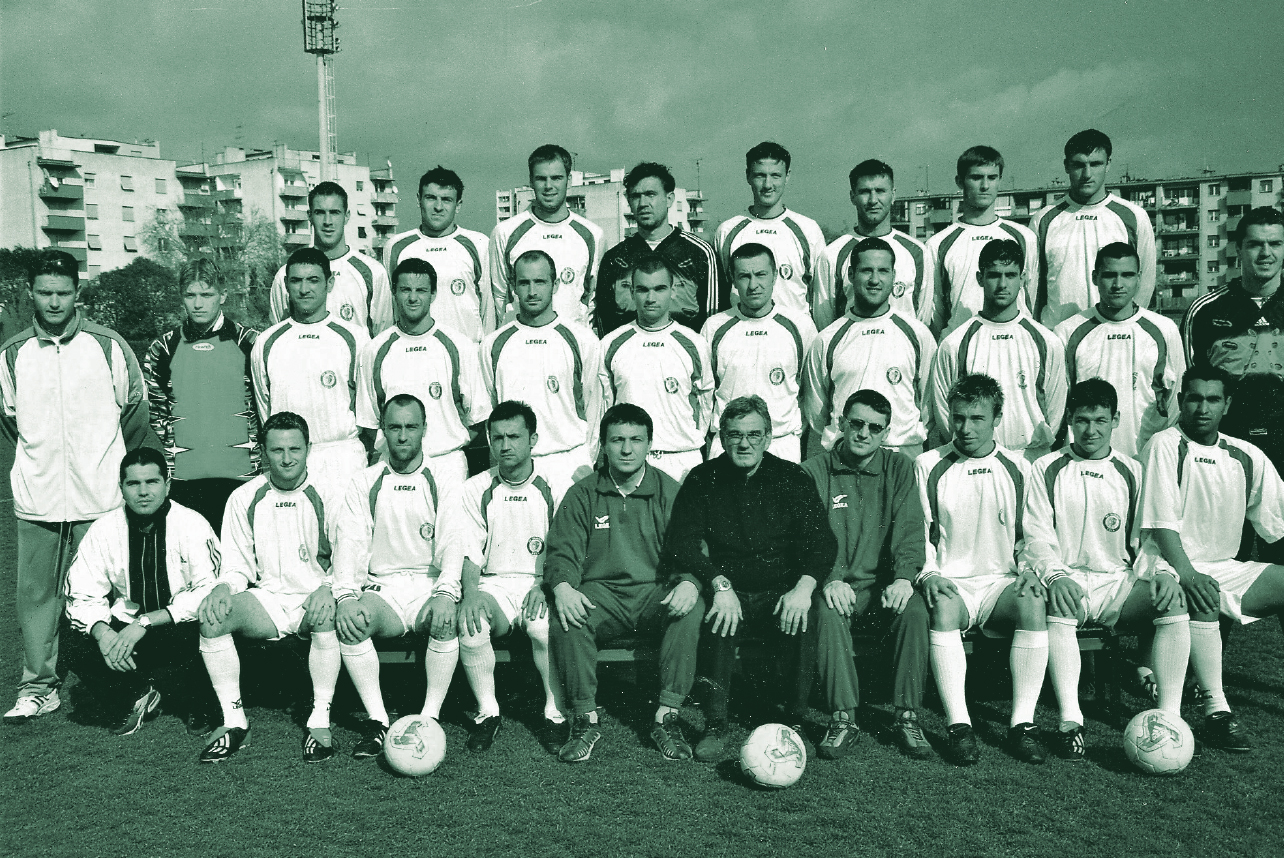
NK Uljanik in 2002/03
Top row: Žiković, (unknown), Pauletić, Ćaleta, Černjul, Trešnjić, Ramadani, Osmanović; middle row: Marjanović (physiotherapist), Grabar, Kurtović, Gortan, Kontešić, Ugrčić, Dadić, Stošić, Šistek, (unknown), Šteko; bottom row: Resan, Ostović, Raković, Lasić, Elvis Scoria (coach), Berislav Poldrugovac, Z. Moravac (assistant coach), Šuran, Deranja, (unknown)
NK Istra and NK Uljanik played their final league match under these names at the Veruda pitch on 22 March 2003. NK Uljanik won the match 3–nil to retake the pinnacle of Pula footballing after over forty years in the shadow of NK Istra.
That year saw NK Istra also relegated out of the Second League; from the 2003/04 season it competed in the Croatian Third League.
In 2003 NK Uljanik achieved certainly the zenith of footballing in Pula and Istra County as a whole. Having eliminated First League squads Osijek and Kamen Ingrad, the team based out of the shipbuilding company secured a bid in the finals of the Croatian Football Cup where it met Hajduk of Split. The achievement was all the greater as it was the first time since Croatian independence that a Second League team had achieved this feat. Hajduk ultimately took the Cup title, winning 1–nil in Pula and 4–nil at home in Split.

The first match of the Croatian Cup final was played in Pula on 21 May 2003 between NK Uljanik and HNK Hajduk (0–1)
It was evident that NK Uljanik had outgrown both its labour union and amateur roots, and the name borne by a state owned and subsidised shipyard. Ahead of the 2003/04 season the management opted to rename the club NK Pula 1856 (the year referencing the founding of the shipyard in Pula).
Having clinched the first spot in the southern division of the Second League the former NK Uljanik, now sporting its new name NK Pula 1856, had to best NK Međimurje of Čakovec in a qualification fixture to earn promotion to the First League. A 2–nil loss at the away game in Čakovec was followed by the home match at Pula’s stadium. The match went into extra time and a penalty shootout. The hero of the day was young Pula goalkeeper Ervin Radulović; he blocked four penalty attempts and led the Pula squad into the First League.
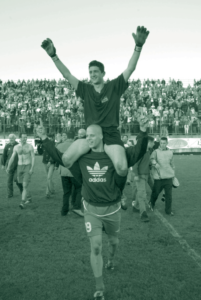
The hero of the match Ervin Radulović on the
shoulders of teammate Saša Kolić

The club was rechristened again for the 2005/06 season after signing a sponsorship agreement with brewer Pivovara Daruvar, replacing the NK Pula 1856 moniker with the new name NK Pula Staro češko.
The sponsorship agreement was not renewed at the end of the season and the team continued play in the First League’s 2006/07 season as NK Pula.
In the summer of 2007, after a number of unsuccessful attempts to achieve a merger with NK Istra, now playing in the Third League, the club adopted the name NK Istra 1961.
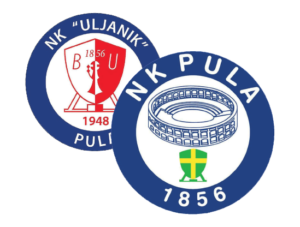
Pula’s top club kept alive the heritage of the NK Istra name, the club that had—since its founding in 1961 and the merger of NK Pula and NK Uljanik—nurtured the best footballers in the City of Pula and Istra County.
Having secured the Second League title in the 2008/09 season, NK Istra 1961 under the leadership of coach Elvis Scoria once again joined the ranks of the First League.
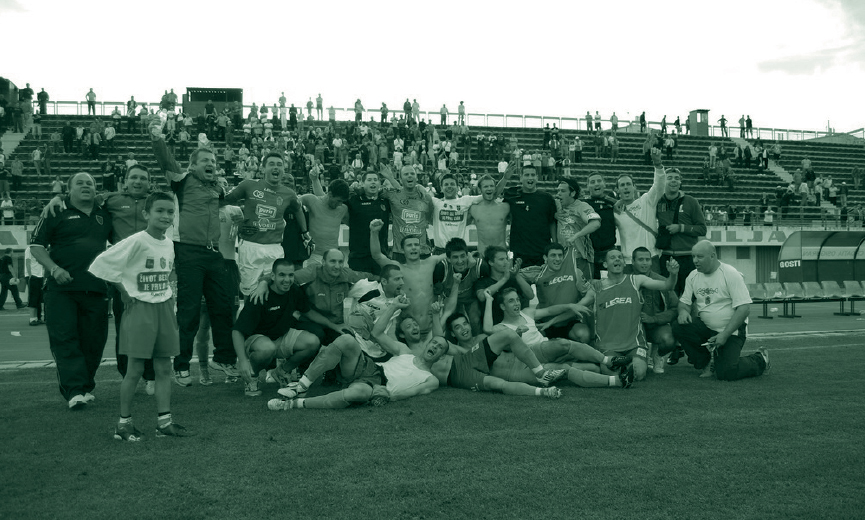
The players of NK Istra 1961 celebrate after clinching the champion’s title in Second League play, earning them promotion to the First League in 2009
In late 2009 the general meeting of NK Istra 1961 chose Russian businessman Mikhail Shcheglov to the helm of the club, the first foreign national to lead a Croatian sports team. The meeting also re-registered the club, transitioning from an association to a sports joint stock company, the first step to privatisation.
The completion of all works on Pula’s new stadium was celebrated on 11 February 2011 with a friendly match between the Croatian and Czech national sides. The capacity crowd of 9,000 at the new stadium cheered the Croatian team to a 4–2 win.
In June of 2015 a consortium of American investors represented by lawyer Michael Glover purchased a majority stake in the club from Mikhail Shcheglov.
After three seasons of league competition the American stakeholders backed out of their investment during the 2017/18 season, putting NK Istra in a precarious financial position that put the club’s future in jeopardy. Pula’s footballers, faced with no sources of financing, and left to the resources of a handful of the friends and supporters of the club, wrote some of the most dramatic and moving pages in Pula’s footballing history.
In spite of the challenges the players that did not abandon the club during the winter break, a number of players loaned from other clubs, the juniors led by coach Darko Raić Sudar, and captain Aljoša Vojnović went forward with training ahead of the spring leg of the season. In two qualification matches with NK Varaždin the team held on to its First League spot.
The NK Istra 1961 line-up for the deciding qualification match in Varaždin: Marijan Ćorić, Aleksandar Jovičić, Ivan Zgrablić, Franjo Prce, Antonio Pavić, Aljoša Vojnović, Kristijan Jakić, Renato Escobar Barufi, Dino Halilović, Goran Roce, and Andrea Ottochian.
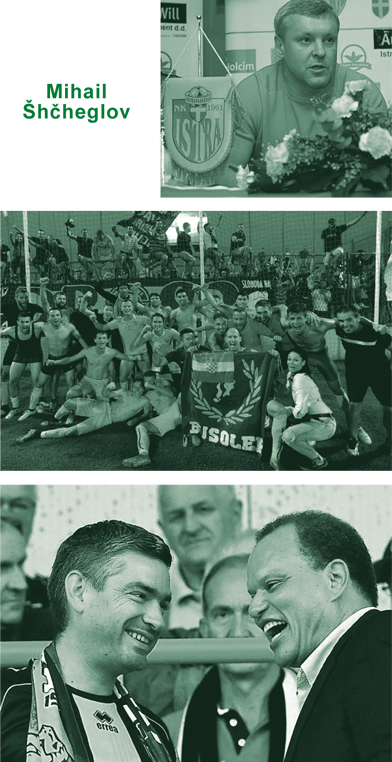
Above: Michael Glover with Pula Mayor Boris Miletić
Under: Varaždin, 2 June 2018: players and fans celebrate after
the qualification match that kept the club in the First Croatian Football League

President Branko Devide Vincenti and NK Istra 1961 director Mikel Lauzurica with Pula Mayor Boris Miletić
Pula, 14 April 2021: players and coaching staff celebrate a 3–2 win over HNK Rijeka

The Karbonina pitch was revamped in 2010 with the installation of artificial turf and floodlights. Generations of Pula footballers could wistfully recall the old Karbonina pitch where lower ranked Pula teams honed their skills, with the first matches starting early Sunday morning and the final games running to the last rays of the setting sun.
From 1912 this was the site of the A.S. Edera club football grounds, Pula’s first proper pitch.
Once turf had been installed at the city’s stadium, the Karbonina pitch was the site of matches played by city clubs Avijatičar, Duga, Staklar, Šijana, Uljanik and all the junior squads of Pula’s clubs.

NK Šijana in 1971
Standing: Krstulović, Rojnić, F. Kozić, Soldatić, Glazduri, Višković;
squatting: Pericin, V. Škropeta, Mihajlović, Likar, Brusić
NK Staklar in 1972
Standing: Bogojević, Vidak, Samuelle, Paoli, Karović, Brunjak;
squatting: Simeunović, Kordiš, Turčinov, Šaina, Jalovec
Karbonina legends Gigi Paoli,
Roko Peruško and Dule Vidak
A vital chapter in Pula’s football story has been written by the fans of the sport. Among the most venerable were Marcello Stiglich, remembered by older Pula residents as a fiery fan of the Grion club and for his memorable catchphrase, “sempre allegri, mai pasion, viva il Grion,” cheering on his favoured squad after it was promoted to the Serie B of the Italian championship in the 1931/32 season, certainly the most momentous achievement of Pula footballers in the period before the Second World War.
In the period following the great war we remember Mr Rudella, a devotee of Pula’s top club, USO. He never missed even the club’s training sessions.
When NK Istra was formed in 1961 by the merger of NK Uljanik and NK Pula its greatest fan was the then already eighty-two-year-old Toni Zorzetti from the Kaštanjer quarter.

NK Istra fans in Rijeka’s Krimeja following a 1962 win over the Orijent club
Capitano with a banner
on the grandstands of the
Pula stadium
The Demoni founders in 1992
The “Banana” brothers
One of the legendary NK Istra fans of the 1960s was Rudi, also remembered as Pula’s last active porter. A fixture of the city, always on the move, he always returned a greeting with the words “Viva Istra”, and older Pula residents remember him by his nickname Rudi Viva Istra.
Rudi was followed by the cheerleading enthusiasm and thunderous voice of Capitano. Providing him support from the roofs of the ticket booths were the Zimolo twins, fondly known to all as the “Banana” brothers. A few years later they would go on to be the unrivalled leaders of Pula’s football fans.
With Pula’s top club active in First League competition, 1992 saw the founding of Demoni, the first organised fan club. Always true to the city’s top footballing association the group worked with the club during its rechristening in 2007 to NK Istra 1961. Along with the support they provide at home and away matches, Demoni fans are active in humanitarian activities.

A match between NK Istra and HNK Rijeka was the first
match in Croatian football history to be cut short due to signal
flares thrown on the pitch
The Demoni fans on the stadium’s north grandstands
NK Istra and A.S. Edera membership cards
A match between NK Istra 1961 and HNK Rijeka played on 1 April 2012 at Pula’s stadium was the first match in Croatian football history to be cut short when fans threw signal flares on the pitch. The match was cut short in the 71st minute when members of the Demoni fan club threw four flares while celebrating a goal scored by their side.
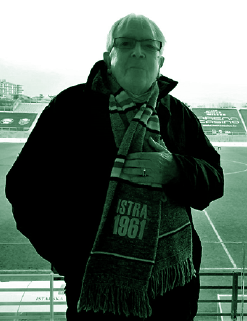
NK Istra’s oldest fan Albino Padjen “Mača”
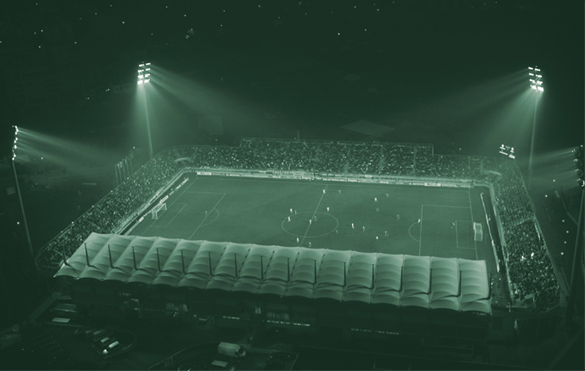
The competition of work on the new city stadium was celebrated on 11 february 2011 with a friendly match between the Croatian and Chez National teams (4-2).

